
- •Table of contents
- •Abbreviations and Acronyms
- •Executive summary
- •Introduction
- •Institutional arrangements for tax administration
- •Key points
- •Introduction
- •The revenue body as an institution
- •The extent of revenue body autonomy
- •Scope of responsibilities of the revenue body
- •Special governance arrangements
- •Special institutional arrangements for dealing with taxpayers’ complaints
- •Bibliography
- •The organisation of revenue bodies
- •Getting organised to collect taxes
- •Office networks for tax administration
- •Large taxpayer operations
- •Managing the tax affairs of high net worth individuals taxpayers
- •Bibliography
- •Selected aspects of strategic management
- •Key points and observations
- •Managing for improved performance
- •Reporting revenue body performance
- •Summary observations
- •Managing and improving taxpayers’ compliance
- •Bibliography
- •Human resource management and tax administration
- •Key points
- •Aspects of HRM Strategy
- •Changes in policy in aspects of HRM within revenue bodies
- •Staff metrics: Staff numbers and attrition, age profiles and qualifications
- •Resources of national revenue bodies
- •Key points and observations
- •The resources of national revenue bodies
- •Impacts of recent Government decisions on revenue bodies’ budgets
- •Overall tax administration expenditure
- •Measures of relative costs of administration
- •International comparisons of administrative expenditure and staffing
- •Bibliography
- •Operational performance of revenue bodies
- •Key points and observations
- •Tax revenue collections
- •Refunds of taxes
- •Taxpayer service delivery
- •Are you being served? Revenue bodies’ use of service delivery standards
- •Tax verification activities
- •Tax disputes
- •Tax debts and their collection
- •Bibliography
- •The use of electronic services in tax administration
- •Key points
- •Provision and use of modern electronic services
- •Bibliography
- •Tax administration and tax intermediaries
- •Introduction
- •The population and work volumes of tax intermediaries
- •Regulation of tax intermediaries
- •The services and support provided to tax intermediaries
- •Bibliography
- •Legislated administrative frameworks for tax administration
- •Key findings and observations
- •Introduction
- •Taxpayers’ rights and charters
- •Access to tax rulings
- •Taxpayer registration
- •Collection and assessment of taxes
- •Administrative review
- •Enforced collection of unpaid taxes
- •Information and access powers
- •Tax offences (including policies for voluntary disclosures)
- •Bibliography

9. LEGISLATED ADMINISTRATIVE FRAMEWORKS FOR TAX ADMINISTRATION – 289
Collection and assessment of taxes
Income taxes
The policy decisions that shape the frameworks for collecting and assessing taxes are often influenced by decisions made outside a revenue body’s control. However, these decisions can have significant implications for the compliance burden imposed on taxpayers, how the tax system is to be administered and the resulting workload for the revenue body, as well as general efficiency and effectiveness considerations. This section focuses on arrangements for the collection and assessment of income taxes.
Overview – withholding regimes
Withholding at source arrangements are generally regarded as the cornerstone of an effective income tax system. Imposing the obligation on independent third parties such as employers and financial institutions to withhold an amount of tax from payments of income to taxpayers: 1) significantly reduces, if not eliminates, their ability to understate such income for tax assessment purposes; 2) is a more cost efficient way for both taxpayers and the revenue body to transact the payment of taxes; and 3) it reduces the incidence of unpaid taxes that might otherwise arise where taxpayers properly report their income but are unable to pay some/all of the tax assessed.
Published research findings of selected revenue bodies (Swedish Tax Agency, 2008, United Kingdom HMRC, 2012; United States IRS, 2012) clearly indicate that there are significant compliance-related benefits from the use of withholding. Furthermore, the timely remittance of amounts withheld by payers to the revenue body ensures a good flow of revenue to Government accounts and thereby facilitates budgetary management.
In practice, withholding is most commonly applied to employment income – of the 52 countries covered by this series only four (i.e. France, Hong Kong, Singapore and Switzerland) do not use withholding regimes for the collection of personal income tax from employment income, although in the case of France, withholding is applied for the collection of SSC from employment income. In all four countries, reporting regimes ensure that the revenue body has a record of each employee’s annual employment income, facilitating the checking of tax returns, while taxpayers are generally required to make advance payments of tax.
Withholding regimes for employment income
As already noted, withholding regimes are almost universally applied for the collection of personal income tax on employment income. However, there are some significant differences in the design of these regimes, with implications for how they operate in practice and the responsibilities and costs they impose on employers, taxpayers and revenue bodies.
1) Cumulative withholding regimes
The objective of the cumulative approach to employee withholding is to ensure that for the majority of employees the total amount of taxes withheld over the course of a fiscal year matches their full-year tax liability. To the extent this is achieved, employees are freed of the obligation to prepare and file an annual tax return, the primary benefit frequently attributed to the cumulative approach. Under this approach, employees are required to provide employers with details of relevant entitlements to assist them determine the amount of tax to be deducted from their earnings. In some countries (e.g. Ireland and UK), employees provide this information to the revenue body which in turn advises the employer
TAX ADMINISTRATION 2013: COMPARATIVE INFORMATION ON OECD AND OTHER ADVANCED AND EMERGING ECONOMIES – © OECD 2013

290 – 9. LEGISLATED ADMINISTRATIVE FRAMEWORKS FOR TAX ADMINISTRATION
of a code that determines the amount of tax to be deducted from earnings. Employers withhold tax from income paid, as required, determining amounts to be withheld on a progressive/cumulative basis over the course of the fiscal year. Employees changing jobs during the course of a fiscal year must inform their new employer of their tax position and, in some countries, the revenue body as well.
Under the cumulative approach, employees tend to have few entitlements (that reduce tax payable) as this enables greater accuracy in calculating the amount of taxes withheld over the course of a fiscal year vis-à-vis their end-of year tax liabilities. However, in two countries (i.e. Japan and Korea), employee taxpayers can present details of certain deductions/entitlements to their employers towards the end of the fiscal year for an adjustment to their overall withholdings for the year.
Employers report annually or more regularly in some countries, to revenue bodies on incomes paid and taxes withheld in respect of individual employees. Increasingly, this reporting is being done using electronic reporting methods. For some countries, this reporting facilitates checks that are carried out to ensure that the correct amount of tax has been paid and/or to determine whether taxpayers are required to file a tax return. In practice, the operation of withholding regimes for other categories of income (e.g. for interest income) complement the employment cumulative withholding arrangements and together ensure that most employees are not required to file an end-year tax return.
The United Kingdom’s PAYE system, administered by HMRC, is based on the cumulative approach, and its operation is depicted in Figure 9.1.
Figure 9.1. Key stages in the PAYE annual cycle
Four main activities take place annually within the PAYE system
Annual coding |
In-year processing |
End-of-year returns |
End-year reconciliation |
HMRC issues coding notices to both individuals & employers, based on latest information.
Employers apply the new tax coding to individuals to determine net pay and tax deductions.
Individuals contact HMRC with questions relating to their new tax coding.
Employers deduct tax (using tax code) and National Insurance contributions and pay these to HMRC.
Employers send HMRC information about employees starting or leaving.
HMRC updates its records for employee movements and provides employers with a tax code for new employees.
Source: United Kingdom National Audit Office (2012).
Employers send HMRC information about total amount of tax & National Insurance deducted and paid over in the year, together with details of employment income and deductions by employee.
HMRC matches monthly deductions paid to the amounts declared in the end-of-year returns.
HMRC matches returns for individuals to its records & reconciles their tax & National Insurance deductions with their employment income.
HMRC updates its record of pay & tax details & issues a revised tax coding notice, where necessary.
Where additional tax is payable, HMRC may adjust the tax code for a subsequent year to collect the balance through the PAYE system, or the individual can pay the amount in full immediately. HMRC repays any overpayments of tax.
2) Non-cumulative withholding
The alternate approach to withholding on employment income is described as “noncumulative”. By way of contrast, the non-cumulative withholding approach operates on a “pay period” basis for each employee. Under this approach, employers withhold taxes for each pay period having regard to their gross income, known entitlements (that may reduce the amount to be withheld) and the rate of withholding to be applied. Where an employee changes jobs, the new employer simply commences the withholding process on the employee’s future income without regard to his/her previous employment withholdings.
TAX ADMINISTRATION 2013: COMPARATIVE INFORMATION ON OECD AND OTHER ADVANCED AND EMERGING ECONOMIES – © OECD 2013

9. LEGISLATED ADMINISTRATIVE FRAMEWORKS FOR TAX ADMINISTRATION – 291
However, as this approach involves a less precise form of withholding, the amount deducted for each employee over the course of a fiscal year represents only an approximation of their full-year tax liability. In these circumstances, employees are normally required to file annual tax returns to ensure that the correct overall amount of tax is paid (and to obtain a refund of any overpaid tax), taking account of all categories of assessable income and entitlements (e.g. tax deductions and credits), as well as any other responsibilities administered by the revenue body that may be linked to the personal tax system (e.g. collection of student loans).
Information on the regimes of employers’ withholding, payment and reporting obligations of surveyed revenue bodies is set out in Table 9.7. Among other things, this table reveals that of the 48 revenue bodies administering employer withholding regimes, around two thirds administer “cumulative” type regimes. These include OECD countries such as Ireland, Japan, Korea, New Zealand, Spain, and the United Kingdom, and selected other countries such as Argentina, Bulgaria and South Africa. Use of the non-cumulative withholding approach is limited to less than half of surveyed countries, including Australia, Canada, Finland, Malaysia, Malta, Norway, Portugal, Sweden, and the USA.
3) The pros and cons of cumulative and non-cumulative regimes
Providing an exhaustive account of the advantages and disadvantages of both the cumulative and non-cumulative approaches is beyond the scope of this series, particularly given the many differences in the personal tax legislative framework applying from country to country. However, it is possible to make some general observations, drawing on various published reports and other FTA work.
Concerning the cumulative approach, the view is sometimes expressed that it is highly attractive (and beneficial) because it eliminates the requirement for annual tax returns from most employees, which would otherwise have to be processed by the revenue body. In other words, applying this approach frees large numbers of employees of a significant compliance burden while the revenue body avoids the cost of processing tax returns. These arguments are particularly relevant and persuasive in countries with relatively new tax systems where the level of awareness and understanding of the tax system is likely to be very low, and/or where the costs of having most employees prepare tax returns which must be processed by the revenue body are likely to be significant. However, the administration of cumulative regimes presents some additional costs which may be significant depending on a range of factors (e.g. the degree of automation and complexity of tax law). Such regimes, with their objective of achieving an exact amount of withholding pay-by-pay, can be costly for employers to administer and their operation requires considerable in-year administrative action by the revenue body (e.g. dealing with adjustments to entitlements and changes of employment that affect an employee’s withholding) to achieve withholding precision. The extent of these costs will depend on a variety of factors, including the extent of employment mobility and tax law complexity.
The CIS 2010 edition recounted the experiences of revenue bodies in New Zealand and the United Kingdom concerning issues that had arisen in the administration of their respective systems of cumulative PAYE, and made reference to a number of possible solutions being considered. Boxes 9.4 and 9.5 provide an update on how these revenue bodies are moving ahead.
In countries where employees are generally required to prepare and file end-year tax returns to reconcile their fiscal year tax situation, including those using non-cumulative PAYE regimes, significant costs potentially arise for taxpayers and the revenue body from the
TAX ADMINISTRATION 2013: COMPARATIVE INFORMATION ON OECD AND OTHER ADVANCED AND EMERGING ECONOMIES – © OECD 2013

292 – 9. LEGISLATED ADMINISTRATIVE FRAMEWORKS FOR TAX ADMINISTRATION
Box 9.4. New Zealand: Making tax time easier proposals
In June 2010, the New Zealand Government released a discussion document Making tax easier and consulted the public with an online forum. The document proposed changes which support the Government’s goal of a tax system that encourages innovation and growth, without imposing unnecessary compliance costs upon taxpayers. With this in mind, the discussion document and forum outlined several proposals to reform the way tax is administered. The key proposals were:
Reduce the use of paper forms in administering the tax system and increase online services and technology, including a proposal to mandate the use of electronic services
Reform the PAYE and personal tax summary process, including a proposal to make PAYE a final tax for many taxpayers; and
Introduce a new framework for sharing information, where appropriate and with safeguards, with other government agencies.
While generally supportive of the overall objective to make tax administration more efficient by making greater use of online services, submissions were not supportive of the proposals to mandate their use, or of the proposal to make PAYE a final tax. The Government has taken into account the views expressed by submitters, while still aiming to achieve the Government’s goals for an efficient, innovative tax system. The changes passed into law in 2012 will take effect in the 2016/17 tax year. They include:
Requiring taxpayers who choose to file a tax return to do so for the previous four years as well as for the current year;
Removing the requirement for taxpayers to file an income tax return merely because they receive the family benefit, “Working for Families”;
Allowing the Commissioner of Inland Revenue to authorise data storage providers to store their clients’ tax records offshore, and being able to revoke any such authorisation; and
Allowing taxpayers who submit their returns electronically to store them electronically.
Overall, these proposals should reduce compliance costs for businesses and individuals, while helping Inland Revenue to achieve its goal of delivering the bulk of its services online in future. The proposals will also be supplemented by an internal strategy aimed at moving taxpayers to electronic services.
The Making tax easier initiative has been incorporated into the Business Transformation programme which is described in Chapter 2.
Source. CIS survey reponse from NZ IR (February 2013).
requirement to prepare and process tax returns. However, over the last two decades technology has increasingly been used to significantly streamline and automate these processes and reduce their attendant costs. These developments include, as described in Chapter 7 of the series, electronic filing and, most importantly, the use of fully or partially completed pre-filled tax returns that can be accessed electronically by taxpayers and their representatives.
At the end of the day, these quite different approaches to personal tax administration for employee taxpayers turn largely on whether absolute precision in pay-by-pay withholdings is an objective worth pursuing for the majority of employees, or whether a simpler approach entailing approximate in-year withholdings and an end-year reconciliation (largely automated) is to be preferred. Factors such as the complexity of the tax law and demographic factors (e.g. ageing populations with a more diverse range of incomes) are likely to be quite relevant to these considerations and may have quite different applicability across the 52 countries covered by this series.
Tables 9.5 and 9.6 set out information on the extent of withholding and related information reporting obligations across revenue bodies in respect of both resident and non-resident
TAX ADMINISTRATION 2013: COMPARATIVE INFORMATION ON OECD AND OTHER ADVANCED AND EMERGING ECONOMIES – © OECD 2013

9. LEGISLATED ADMINISTRATIVE FRAMEWORKS FOR TAX ADMINISTRATION – 293
Box 9.5. United Kingdom: Issues in PAYE administration and possible solutions
In commenting on UK’s PAYE regime in 2010, UK audit authorities noted that
The Department’s former PAYE computer systems were designed at a time when it was usual for people to have one source of employment and not change employer very frequently. The systems therefore structured records around employments rather than individual taxpayers, and these were held in 12 regional databases which were assigned to specific tax offices. Working patterns have changed, with many taxpayers having more than one job or frequently moving jobs (such as students), and the number of people with multiple sources of income (such as working pensioners) has increased. As the Department’s records of some individuals’ employments have become spread across more than one of its regional databases, it became increasingly difficult for it to bring together a complete picture of an individual’s employments identifying all relevant sources of income, increasing the risk of people paying the incorrect amount of tax.
The challenges in processing PAYE have contributed to an increase in the volume of cases identified through the Department’s end of year reconciliation process that require manual checking […].
Over recent years, HMRC has introduced a major upgrade of its PAYE service that, among other things, brings together all employment records, thereby enabling it to produce a complete picture of each individual’s employment and pension income. This enhancement is expected to produce considerable benefits although, as noted above, there remains a considerable backlog of open cases.
In a consultation paper published in July 2010, HMRC set out a number of reform options for consultation with a view to their possible adoption over the medium/long term. These included a proposal to move to a system of real-time information where the majority of employers would report electronically and contemporaneously as wages are paid and taxes withheld. Currently, employers only report individual employees’ aggregate income and deduction details at the end of each fiscal year.
An additional option offered for consideration entailed a system of “centralised deductions”. This idea envisages most/all employers having an electronic interface with HMRC – the employer would send the gross payment through the electronic payment system to a central calculator where the deductions calculated by HMRC would be made automatically. The resulting net payment would be sent to the individual’s bank account and the deductions would be paid directly to Government.
In commenting in 2012 on further developments, UK audit authorities noted:
HMRC is now moving ahead with plans to implement its initiative “Real time information”. As reported in 2012, The next major change for the PAYE service is introducing Real Time Information (RTI), where employers must report employees’ income tax and National Insurance deductions as they pay them rather than at year-end. Under RTI, some elements of the PAYE process will no longer be required, such as employer end-of- year returns and in-year forms for starters and leavers. It should also reduce the time to complete end-of-year reconciliations, increasing the number of automated reconciliations. However, end-of-year reconciliations will still be needed as, for example, the Department would only be notified of benefit in kind information, such as company cars, at the end of the tax year.
The timetable for implementation of RTI is challenging […]. The Department for Work and Pension’s timetable to implement Universal Credit is driving the timetable to roll-out RTI. The Department for Work and Pensions requires real time PAYE information on employment and pension income to award and adjust Universal Credit. It is rolling out Universal Credit from October 2013 to 2017. All employers and pension providers need to be using RTI by October 2013 to meet this timetable. The Department met its milestone to start its RTI pilot in April 2012 with ten employers. By July 2012, it expects a further 310 employers will be using RTI. At 31 May 2012, 209 PAYE schemes covering 1.5 million individual records were using RTI.
Source: Reports by the Comptroller and Auditor General on HMRC Accounts 2009-10 and 2011-12.
TAX ADMINISTRATION 2013: COMPARATIVE INFORMATION ON OECD AND OTHER ADVANCED AND EMERGING ECONOMIES – © OECD 2013

294 – 9. LEGISLATED ADMINISTRATIVE FRAMEWORKS FOR TAX ADMINISTRATION
taxpayers, while Table 9.7 provides more information on the timing and frequency of related payment and reporting obligations. The key observations are set out below:
All but four countries (i.e. France, Hong Kong, Singapore, and Switzerland) apply “withholding at source” requirements for the collection of personal income taxes (and in most countries where applicable, social security contributions) on employment income.
Employers are typically required to deduct tax from salaries and wages and remit withheld taxes on a monthly basis. However, four countries (Australia, Canada, New Zealand, and the United States) expedite the collection of employer withholdings from very large employers through more frequent payment obligations.
To reduce the administrative burden on smaller businesses, around one third of countries provide a bi-monthly, quarterly, and/or annual payment cycle.
The frequency of employers’ income reporting obligation varies significantly across surveyed countries-in around one half, employers must report monthly or quarterly, while for the balance employers are required to report on an annual basis only; this variation in reporting requirements suggests there are substantial differences in the compliance burden imposed on employers and the associated workload of revenue bodies, although it is known that some revenue bodies have taken steps in co-operation with employers to automate much of this regular reporting obligation.
Withholding regimes for other categories of income
In addition to employment income, many countries apply withholding at source arrangements to other categories of income – see Table 9.5. The key observations from the information reported are as follows:
Over two-thirds of revenue bodies administer withholding regimes for the collection of income tax – as a final or creditable tax – in respect of interest income (38 revenue bodies) and dividend income (37 revenue bodies) made to resident taxpayers.
Just over one third of revenue bodies reported the use of withholding arrangements in respect of payments made to certain businesses and others prescribed in their respective tax laws. (Examples of such regimes are set out in Box 9.6.)
Other categories of income subject to withholding were certain rents (18 bodies), royalties and patents (29 bodies), sales of shares (15 bodies), sales of real property (12 bodies).
Use of third party information reporting requirements
In practice, most withholding regimes are complemented by the reporting of information to the revenue body on individual payees (e.g. name of payee, their identification number, amount paid, and amount of taxes withheld). In the absence of a withholding requirement, systems of information reporting in their own right are an important compliance tool for the administration of income tax systems in many countries. As evidenced from the cited US research considerably higher rates of compliance are achievable where income is subject to systematic reporting and matching with tax records, compared to where this is not the case. For the purpose of this series, the term “third party information reporting” refers to a mandatory requirement on prescribed third parties (e.g. businesses, financial institutions, and government agencies) to report payments of income (and other tax-related transactions) and payee details (generally with a taxpayer identifying number) to the revenue body. Traditionally, these reports have been used to verify the information reported by taxpayers
TAX ADMINISTRATION 2013: COMPARATIVE INFORMATION ON OECD AND OTHER ADVANCED AND EMERGING ECONOMIES – © OECD 2013

9. LEGISLATED ADMINISTRATIVE FRAMEWORKS FOR TAX ADMINISTRATION – 295
in their returns. However, a more recent development has seen use of these reports to pre-fill tax returns, which is discussed later in this chapter.
In contrast to the high cost of and low audit coverage that can be achieved with traditional audit processes, comprehensive programmes of information reporting and matching can provide an extremely effective tool to screen a revenue body’s taxpayer records, both to detect non-compliance and to encourage the correct reporting of tax liabilities. However, there are generally two pre-conditions for such arrangements to be sufficiently efficient to make them attractive to revenue bodies: 1) electronic reporting by third parties of information reports; and 2) the use of a high integrity taxpayer identifier to facilitate the matching of information reports with revenue body records.
As indicated in Table 9.5, many countries require the mandatory reporting of payments in respect of salaries and wages, dividend and interest income (much of which is also subject to withholding). However, beyond these categories of payments, use of mandatory third party reporting varies substantially across countries. Examples of revenue bodies with substantial information reporting regimes (that go beyond the traditional categories of employment and investment income) are set out in Box 9.7.
Box 9.6. Withholding regimes and self-employment/business income
Previous FTA work has described how some countries use tax withholding arrangements as the primary method for collecting income tax for categories of self-employment income. Some examples from this work are provided below:
Ireland
Professional Services Withholding Tax: This is a withholding and reporting regime covering prescribed professional services: 1) medical, dental, pharmaceutical, optical, veterinary; 2) architectural, engineering, surveying and related services; 3) accounting, auditing, finance, advertising, marketing; 4) legal services; and 5) geological services.
Relevant contracts tax: The regime applies to payments by principal contactors for construction, forestry and meat processing operations. Since 2012, all contracts entered into and payments made must be notified to Irish Revenue in real time using Revenue’s Online Service (ROS). Revenue respond to payment notifications in real time advising the principal contractor of the rate of tax to be deducted from the payment to the subcontractor.
For compliant subcontractors the rate of tax to be applied is 0%. For substantially compliant subcontractors, the rate of tax to be applied is 20%. Where the subcontractor is unknown to Revenue, or has serious compliance issues that are not being addressed, the rate of tax to be applied is 20%. The subcontractor will automatically be credited with the deducted tax for offset against any other tax liabilities they may have. Any excess tax can only be refunded once the annual Income Tax or Corporation Tax return for the period has been filed.
The return filing frequency for the principal contractor is either monthly or quarterly, depending on size. Revenue pre-populate a summary based on the payment notifications made by the principal during the return period and make this summary available through ROS. The principal has the opportunity to make amendments to the summary and sign and submit an amended return. Otherwise, the summary automatically becomes the return on the return filing date. As all information is now supplied either monthly or quarterly, there is no annual return.
United Kingdom
Construction industry scheme (CIS): The CIS is a withholding and reporting regime for contractors in the construction industry. A contractor may be a construction company and building firm, as well as a Government department or local authority and other businesses known in the industry as “clients”. Non-construction businesses or other concerns are treated as contractors if their average annual expenditure on construction operations over a period of 3 years is GBP 1 million or more. Contractors must withhold tax at varying rates from payments to subcontractors unless the subcontractor is entitled to exemption from withholding. Sub-contractors who can pass a business test, a turnover test, and a good compliance test administered by the revenue body can be paid “gross” (i.e. no withholding).
Sources: Withholding and Information Reporting Regimes for Small/Medium-sized Businesses and Self-employed Taxpayers (OECD FTA, September 2009) and Ireland’s CIS 2012 response.
TAX ADMINISTRATION 2013: COMPARATIVE INFORMATION ON OECD AND OTHER ADVANCED AND EMERGING ECONOMIES – © OECD 2013
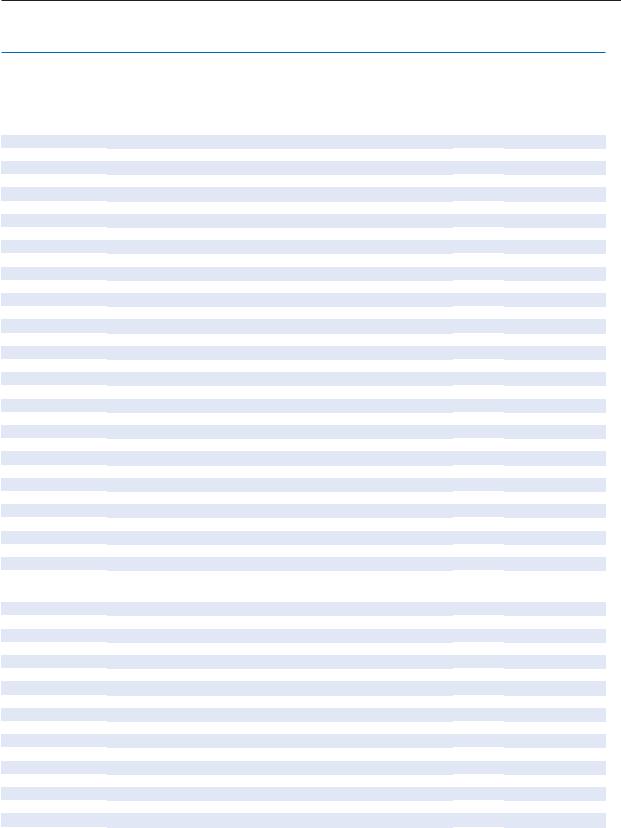
296 – 9. LEGISLATED ADMINISTRATIVE FRAMEWORKS FOR TAX ADMINISTRATION
Table 9.5. Withholding and reporting regimes for income of resident taxpayers
|
Type of income normally subject to withholding (W) and/or reporting (R) where paid to resident taxpayer |
||||||||
|
Wages |
|
|
|
Prescribed |
|
Sale/purchase |
Other |
|
|
and |
|
|
|
business/ |
Royalties |
|
|
income |
|
|
|
|
|
|
||||
Country |
salaries |
Dividends |
Interest |
Rents |
self-employed |
and patents |
Shares |
Real estate |
types |
OECD countries |
|
|
|
|
|
|
|
|
|
Australia/1 |
W, R |
R |
R |
- |
- |
- |
- |
- |
- |
Austria/1 |
W, R |
W |
W |
- |
R/1 |
- |
W |
W, R |
- |
Belgium/1 |
W, R |
W |
W |
W, R |
R/1 |
W, R |
- |
R |
- |
Canada/1 |
W, R |
R |
R |
- |
R |
R |
R |
R/1 |
W, R |
Chile |
W, R |
R |
W/1, R |
R/1 |
W, R |
- |
R |
R |
W, R/1 |
Czech Rep. |
W |
W |
W |
- |
R |
- |
- |
- |
W |
Denmark/1 |
W, R |
R |
R |
R |
- |
W, R |
- |
- |
W, R/1 |
Estonia/1 |
W, R |
-/1 |
- |
W, R |
- |
W, R |
R |
- |
W, R |
Finland/1 |
W, R |
W, R |
W, R/1 |
- |
W, R |
W, R |
R/1 |
R |
W, R |
France |
R |
R/1 |
R/1 |
R |
R |
R |
R |
R |
R |
Germany/1 |
W, R |
W |
W |
- |
- |
- |
W |
R |
R |
Greece |
W, R |
W, R |
W, R |
R/1 |
W, R |
W, R |
R |
W, R |
- |
Hungary/1 |
W, R |
W, R |
W |
W, R |
- |
W, R |
- |
- |
W, R |
Iceland |
W, R |
W, R |
W, R |
R |
W,R |
R |
R |
- |
W, R |
Ireland/1 |
W, R |
W, R |
W, R |
- |
W/1, R |
W, R |
- |
R |
- |
Israel |
W, R |
W, R |
W, R |
W, R |
W, R |
W, R |
W, R |
W, R |
W, R |
Italy/1 |
W, R |
W, R/1 |
W |
- |
W, R |
W, R |
W, R/1 |
- |
- |
Japan/1 |
W, R |
W, R |
W, R |
R |
W, R |
W, R |
W, R |
R |
/1 |
Korea/1 |
W, R |
W, R |
W, R |
R |
W, R |
W, R |
- |
- |
W, R/1 |
Luxembourg |
W, R |
W |
W/1 |
W, R |
- |
- |
- |
- |
- |
Mexico/1 |
W, R |
R |
W, R |
W, R |
W, R/1 |
W, R |
W, R |
W, R |
W, R |
Netherlands |
W, R |
W |
R/1 |
- |
W,R/2 |
- |
R/3 |
R/3 |
- |
New Zealand |
W, R |
W/1, R |
W, R |
- |
W, R |
- |
- |
- |
- |
Norway |
W, R |
W, R |
R |
- |
R |
- |
R |
- |
- |
Poland |
W, R |
W |
W |
- |
- |
W, R |
R |
- |
W, R |
Portugal/1 |
W, R |
W, R |
W, R |
W/1, R |
W/1, R |
W, R |
R |
R |
- |
Slovak Rep/1 |
W, R |
- |
W, R |
R |
R |
W, R |
R |
R |
W, R |
Slovenia |
W, R |
W, R |
W, R/1 |
W, R |
W, R/1 |
W, R |
- |
- |
- |
Spain |
W, R |
W, R |
W, R |
W, R |
W/1, R |
W, R |
R |
R |
W/1, R |
Sweden |
W, R |
W, R |
W, R |
R |
- |
R |
R |
R |
R |
Switzerland |
W, R/1 |
W |
W |
- |
R |
- |
- |
- |
- |
Turkey |
W, R |
W, R |
W, R |
W, R |
W, R |
W, R |
W, R |
- |
- |
United Kingdom |
W, R |
- |
W, R/1 |
- |
W, R/2 |
W, R |
W, R |
R |
- |
United States |
W, R |
R |
R |
- |
- |
- |
R |
- |
- |
Non-OECD countries |
|
|
|
|
|
|
|
|
|
Argentina |
W, R |
W, R |
W, R |
W, R |
W, R |
W, R |
R |
W, R |
W, R |
Brazil |
W, R |
R |
W, R |
R |
W, R |
W, R |
W, R |
R |
R |
Bulgaria |
W, R |
W, R |
- |
R |
R |
W, R |
R |
R |
- |
China |
W, R |
W, R |
W, R |
R |
W, R |
W, R |
W, R |
R |
- |
Colombia |
W, R |
W, R |
W, R |
W, R |
W, R |
W, R |
W, R |
W, R |
W, R |
Cyprus |
W, R |
W, R |
w |
w,r/3 |
- |
- |
R/1 |
R/2 |
- |
Hong Kong, China |
R |
- |
- |
- |
R |
- |
- |
- |
- |
India |
W |
W |
W |
W |
- |
- |
- |
W |
- |
Indonesia |
W, R |
W, R |
W, R |
W, R |
W, R |
W, R |
W, R |
W, R |
W, R |
Latvia |
W, R |
W, R |
W, R |
W, R/1 |
R |
W, R |
R |
R/1 |
- |
Lithuania |
W, R |
W, R |
W, R |
W, R |
R |
W, R |
R |
R |
W, R |
Malaysia |
W, R |
- |
- |
- |
-R |
- |
- |
W/1, R |
- |
Malta |
W, R |
W, R |
W, R |
- |
- |
- |
W, R |
W, R |
- |
Romania |
W, R |
W, R |
W, R |
- |
W, R/1 |
W, R |
W, R |
W, R |
W, R |
Russia |
W, R |
W, R |
W, R |
W/1, R |
R |
W, R |
W,R |
R |
W, R |
Saudi Arabia |
- |
R |
- |
R |
R |
R |
R |
- |
- |
Singapore |
R |
- |
- |
- |
- |
- |
- |
- |
- |
South Africa |
W, R |
W, R |
R |
- |
- |
- |
R |
- |
W, R |
For notes indicated by “/ (number)”, see Notes to Tables section at the end of the chapter, p. 341. Source: CIS survey responses.
TAX ADMINISTRATION 2013: COMPARATIVE INFORMATION ON OECD AND OTHER ADVANCED AND EMERGING ECONOMIES – © OECD 2013
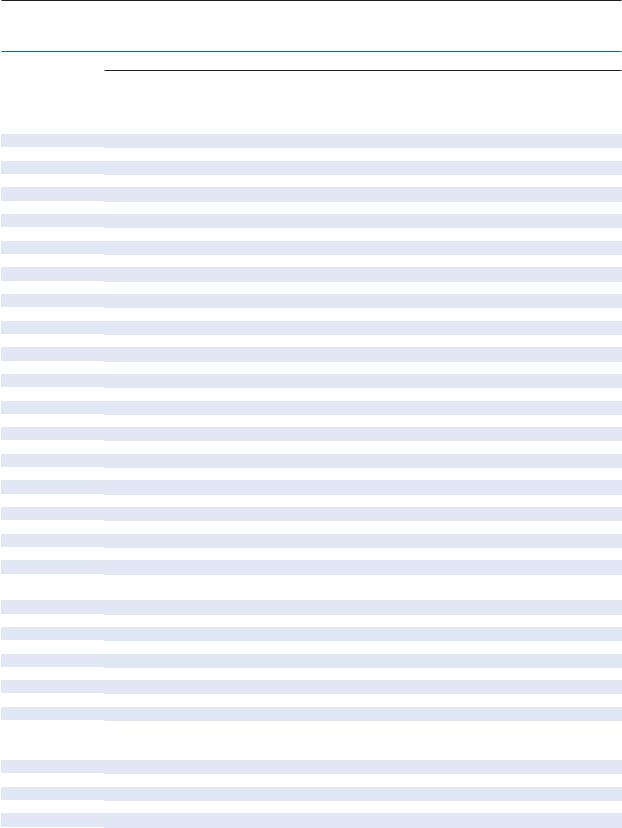
9. LEGISLATED ADMINISTRATIVE FRAMEWORKS FOR TAX ADMINISTRATION – 297
Table 9.6. Withholding and reporting regimes for income of non-resident taxpayers
Type of income normally subject to withholding (W) and/or reporting (R) where paid to non-resident taxpayer
|
|
|
|
|
Prescribed |
|
Sales/purchases |
Other |
|
|
Wages and |
|
|
|
business/ |
Royalties |
|
|
income |
|
|
|
|
|
|
||||
Country |
salaries |
Dividends |
Interest |
Rents |
self-employed |
and patents |
Shares |
Real Estate |
types |
OECD countries |
|
|
|
|
|
|
|
|
|
Australia |
W, R |
W, R |
W, R |
- |
W, R |
W, R |
- |
- |
- |
Austria |
W, R |
W |
W |
- |
W, R |
W |
W |
W, R |
- |
Belgium |
W, R |
W |
W |
W, R |
R |
W, R |
- |
R |
- |
Canada |
W, R |
W, R |
W, R |
W, R |
R |
W, R |
R |
R |
W, R |
Chile |
W, R |
W, R |
W, R |
W, R |
W, R |
W, R |
W, R/1 |
W, R/1 |
W, R |
Czech Rep. |
W, R |
W, R |
W, R |
- |
R |
W, R |
- |
- |
W, R |
Denmark |
W, R |
R |
R |
R |
- |
W, R |
- |
- |
W, R |
Estonia |
|
|
|
|
|
|
|
|
|
Finland |
W, R |
W, R |
R |
- |
W, R |
W, R |
R/1 |
R/1 |
W, R |
France |
W, R |
W, R |
W, R |
R |
R |
W, R |
R |
R |
- |
Germany/1 |
W, R |
W |
- |
- |
W |
W, R |
W |
R |
R/1 |
Greece |
W, R |
W/1, R |
W/1, R |
R/2 |
W, R |
W/1, R |
/3, R |
W, R |
|
Hungary |
W, R |
W, R |
W |
W, R |
- |
W, R |
- |
- |
R |
Iceland |
W, R |
W, R |
W, R |
R |
W, R |
W, R |
W, R |
- |
W, R |
Ireland |
W, R |
R |
W, R |
/1 |
W, R |
W, R |
- |
R |
- |
Israel |
|
|
|
|
|
|
|
|
- |
Italy |
W, R |
W/1, R |
W, R/2 |
- |
W, R |
W, R |
W, R/3 |
- |
|
Japan |
W, R |
W, R |
W, R |
W, R |
W, R |
W, R |
W, R |
W, R |
W, R |
Korea |
W, R |
W, R |
W, R |
R |
W, R |
W, R |
W/1, R |
W/1, R |
W, R |
Luxembourg |
W, R |
W |
|
W, R |
W/1 |
|
|
|
|
Mexico |
W, R |
- |
W, R |
W, R |
W, R |
W, R |
W, R |
W, R |
W, R |
Netherlands |
W, R |
W |
R/1 |
- |
- |
- |
R/ 2 |
R/2 |
- |
New Zealand |
W, R |
R |
W, R |
- |
W, R |
- |
- |
- |
- |
Norway |
W, R |
W |
R |
- |
R |
- |
R |
- |
- |
Poland |
W, R |
W, R |
W, R |
- |
|
W, R |
R |
- |
W, R |
Portugal |
W, R |
W, R |
W, R |
W, R |
W, R |
W, R |
R/1 |
R |
- |
Slovak Rep. |
W, R |
- |
W, R |
W/1, R |
R |
W, R |
R |
R |
W, R |
Slovenia |
- |
- |
- |
- |
- |
- |
- |
- |
- |
Spain |
W, R |
W, R |
W, R |
W, R |
W, R |
W, R |
R |
W, R |
W, R |
Sweden |
W, R |
W, R |
R |
R |
- |
R |
R |
R |
R |
Switzerland/1 |
W, R |
W |
W |
- |
W, R |
- |
- |
- |
- |
Turkey |
W, R |
W, R |
W, R |
- |
W, R |
- |
W, R |
- |
- |
United Kingdom/1 |
R |
- |
W, R |
W, R |
|
W, R |
R |
R |
- |
United States |
W, R |
W, R |
W, R |
- |
W, R |
W, R |
R |
W, R |
W, R |
Non-OECD countries |
|
|
|
|
|
|
|
|
|
Argentina |
/1 |
W, R |
W, R |
W, R |
W, R |
W, R |
W, R |
W, R |
W, R |
Brazil |
W, R |
R |
W, R |
W, R |
W, R |
W, R |
R |
R |
W, R |
Bulgaria |
W, R |
W, R |
- |
R |
R |
W, R |
R |
R |
- |
China |
n.a. |
n.a. |
n.a. |
n.a. |
n.a. |
n.a. |
n.a. |
n.a. |
n.a. |
Colombia |
W, R |
W, R |
W, R |
W, R |
W, R |
W, R |
W, R |
W, R |
W, R |
Cyprus |
W, R/1 |
R |
R/1 |
|
W/1 |
W/1 |
R/1 |
R/1 |
W/1 |
Hong Kong, China |
R |
- |
- |
- |
W, R |
W, R |
- |
- |
- |
India |
W |
W |
W |
W |
- |
W |
- |
W |
- |
Indonesia |
W |
W |
W |
W |
W |
W |
W |
W |
W |
Latvia |
W, R |
W, R |
W, R |
W/1, R |
R |
W, R |
W, R |
W, R |
- |
Lithuania |
W, R |
W, R |
W, R |
W, R |
R |
W, R |
R |
W, R |
- |
Malaysia |
W, R |
- |
W, R |
- |
- |
W, R |
- |
W, R |
- |
Malta |
W, R |
W, R |
R |
- |
- |
- |
W, R |
W, R |
- |
Romania |
W, R |
W, R |
W, R |
- |
W, R |
W, R |
W, R |
W, R |
W, R |
Russia |
W |
W |
W, R/1 |
W, R/1 |
R |
W, R/1 |
W, R/1 |
W, R/1 |
W, R/1 |
Saudi Arabia |
- |
- |
-- |
- |
- |
- |
- |
- |
- |
Singapore/1 |
W, R/2 |
- |
W, R |
W, R |
W, R |
W, R |
- |
W, R |
W, R |
South Africa |
W, R |
W, R |
R/1 |
- |
- |
W, R |
R/2 |
W/3, R |
W, R |
For notes indicated by “/ (number)”, see Notes to Tables section at the end of the chapter, p. 342. Source: CIS survey responses.
TAX ADMINISTRATION 2013: COMPARATIVE INFORMATION ON OECD AND OTHER ADVANCED AND EMERGING ECONOMIES – © OECD 2013

298 – 9. LEGISLATED ADMINISTRATIVE FRAMEWORKS FOR TAX ADMINISTRATION
Box 9.7. Third party reporting regimes for self-employment/business income
Canada’s Contract Payments Reporting System: This is an annual reporting regime introduced in 1999 for payments in the building and construction sector and payments by Government for services provided by business.
Ireland’s system of third party returns: Traders (including farmers), professionals and other persons carrying on a business (incl. non-profit bodies and Government bodies) are required to automatically make third party returns. Broadly, the following payment categories are included: 1) Payments for services rendered in connection with the trade, profession, business, etc., whether paid on your own behalf or on behalf of someone else; 2) Payments for services rendered in connection with the formation, acquisition, development or disposal of the trade or business; and 3) Periodical or lump sum payments made in respect of any copyright. There is a prescribed list of exclusions to these requirements.
United States’ Information reporting: Under the requirements of the US tax code, an extremely wide variety of transactions must be reported to the IRS, generally in electronic format, for matching with tax records. In addition to wages and investment incomes, these transactions include agricultural payments, allocated tips, barter exchange income, brokers’ transactions, capital gains distributions, non-employee compensation and fees, fishing boat crew member proceeds, fish purchases for cash, prescribed gambling winnings, real estate transactions, rents, and sales of securities.
Source: “Withholding and Information Reporting Regimes for Small/Medium-sized Businesses” prepared by the Forum on Tax Administration and published in September 2009.
The potential for the application of information reporting arrangements is best illustrated by data published by the US Internal Revenue Service on the results achieved from its reporting and matching activities that are replicated hereunder for fiscal years 2009 to 2011:
The IRS’s Data Book series notes that information returns include tuition payments, interest and dividend distributions, individual retirement arrangement and medical savings account information, wage and tax statements, certain gambling winnings), and partnership, S corporation and estate/trust distributions).
|
Number or amount reported |
||
Item |
2009 |
2010 |
2011 |
Number of information returns received: |
|
|
|
Total reports (millions) |
2 064 * |
1 834 * |
1 801 |
Paper (millions) |
52 |
47 |
44 |
Electronic (millions) |
1 774 |
1 570 |
1 547 |
Other (e.g. wage data from Social Security Administration (millions) |
239 |
216 |
210 |
Automated Under-reporter program: |
|
|
|
Number of contacts (closed cases, millions) |
3.621 |
4.336 |
4 703 |
Amount of additional assessments (USD billions) |
6.279 |
7 238 |
6 436 |
Number of full-time equivalent positions used |
1 900 |
2 255 |
2 343 |
Automated Substitute for Return program: ** |
|
|
|
Number of contacts (closed cases, millions) |
1 385 |
1 175 |
1 395 |
Amount of additional assessments (USD billions) |
16.649 |
13.441 |
14 373 |
Number of full-time equivalent positions used |
331 |
326 |
290 |
*2011 Data Book advises that data for 2009 and 2010 concerning numbers of returns received was revised downwards to remove information returns ultimately rejected during IRS processing. The data shown in the table revises what was reported in CIS 2010.
**Under the Automated Substitute for Return Program, the IRS uses information returns from third parties to identify tax return delinquencies, constructs tax returns for certain non-filers based on that third party information, and assesses tax, interest and penalties based on the substitute returns.
Source: IRS Data Books (2009 and 2011).
TAX ADMINISTRATION 2013: COMPARATIVE INFORMATION ON OECD AND OTHER ADVANCED AND EMERGING ECONOMIES – © OECD 2013
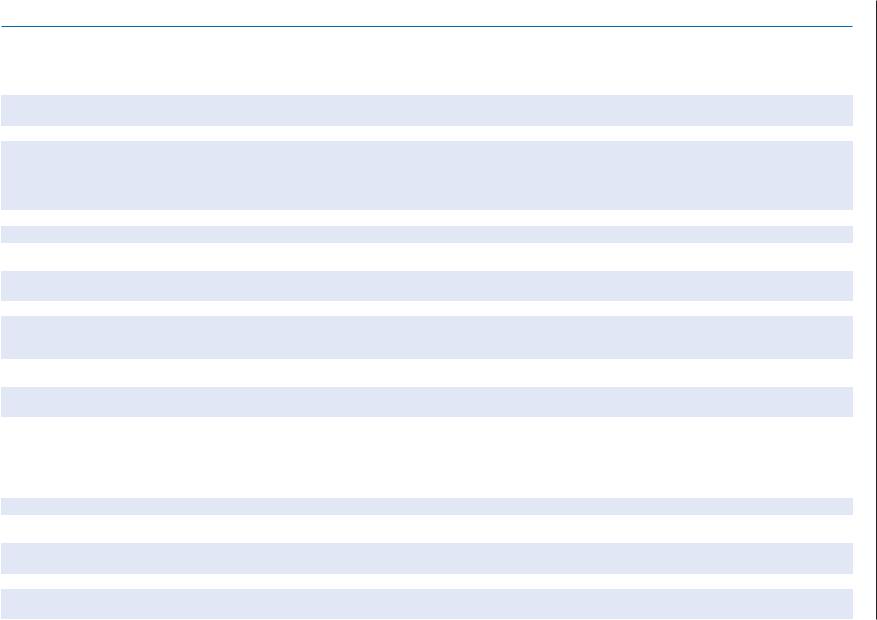
2013 OECD © – ECONOMIES EMERGING AND ADVANCED OTHER AND OECD ON INFORMATION COMPARATIVE 2013: ADMINISTRATION TAX
Table 9.7. Personal income tax. Employers’ withholding, payment, and reporting obligations
|
Employers’ withholding obligation – frequency and time when payable after liability period |
Regime type: |
Employers’ wage reporting obligation Frequency and time when reportable |
||
Country |
In general |
Special rules for prescribed small (S) |
Cumulative or |
In general |
Special rules for prescribed small (S) |
or large (L) employers, if any |
Non-cumulative |
or large (L) employers, if any |
|||
|
|
|
|
|
|
OECD countries |
|
|
|
|
|
Australia/1 |
Monthly – within 21 days |
(S): quarterly-within 21 days: (L)-6 |
Non-cumulative |
Annually-within 6 weeks |
- |
|
|
to 9 days of payment/1; |
|
|
|
Austria |
Monthly – within 15 days |
- |
Cumulative |
Annually – by end February |
- |
Belgium |
Monthly – within 15 days after the month |
Monthly (normally); SME’s: under |
Non-cumulative |
Monthly – within 15 days after the month in |
SME’s: under certain conditions, |
|
in which the income was paid. |
certain conditions, quarterly or |
|
which the income was paid. |
quarterly or yearly – within 15 days |
|
|
yearly – within 15 days after the |
|
|
after the end of liability period |
|
|
end of the period in which the |
|
|
|
|
|
income was paid. |
|
|
|
Canada |
Monthly – by 15th day of following month |
Quarterly or accelerated. |
Non-cumulative |
Annually – by end-February |
- |
Chile/1 |
Monthly – by 12th day of following month/1 |
- |
Cumulative |
Annually – by 23 March after end of tax year |
- |
Czech Rep./1 |
Monthly – by 20th day of following month |
- |
Cumulative |
Annually – by 20th February after end of |
- |
|
|
|
|
income year/1 |
|
Denmark |
Monthly – by 10th day of following month |
Monthly-last weekday in the month |
Cumulative |
Annually – by 20th January after end of |
- |
|
|
of withholding (l) |
|
income year |
|
Estonia |
Monthly – by 10th day of following month |
n.app. |
Non-Cumulative |
Monthly – by 10th day of following month |
- |
Finland |
Monthly – by 12th day of following month |
small employers – quarterly |
Cumulative or |
Monthly – by 7th or 12th of following month |
- |
|
|
|
Non-cumulative/1 |
and annually – by end-January of following |
|
|
|
|
|
year/1 |
|
France |
No employer withholding required |
n.app. |
No withholding |
Annual report of income paid etc. By |
- |
|
|
|
|
31 January of following year |
|
Germany/1 |
Monthly-within 10 days |
Greece |
Bi-monthly submission of payroll |
|
withholding tax return and lump-sum |
|
payment by the 20th day of March, May, |
|
July, September and January of each year. |
Hungary |
Monthly – by 12th day of following month |
Iceland |
Monthly – by 15th day of the following |
|
month |
Ireland |
Monthly – by 14th day of following month |
Israel |
Monthly – by 15th day of following month |
Italy |
Monthly – by 16th day of following month |
Quarterly/annually for smaller |
Cumulative |
Monthly, quarterly, or annually (as per |
See note/1. |
employers – within 10 days/1 |
|
payment cycle-within 10 days |
|
For enterprises with more than 50 |
Non-cumulative |
Annual submission of a final payroll |
n.a. |
employees, the withholding tax |
|
withholding tax return by the end of the last |
|
return is monthly submitted by the |
|
working day of March (for all employees) |
|
20th day of the month following the |
|
|
|
month during which the withholding |
|
|
|
has been effected. |
|
|
|
n.app. |
Non-cumulative |
Monthly – by 12th day of following month |
n.app. |
n.app. |
Non-cumulative/1 |
Monthly – by 15th day of the following |
n.app. |
|
|
month/2 |
|
Quarterly and annually (in very |
Cumulative |
Annually – by 15th February of following |
n.app. |
small cases) |
|
year |
|
n.app. |
Cumulative |
annually – by 31 March of following year |
n.app. |
n.app. |
Cumulative |
Annually – by end of February of following |
n.app. |
|
|
year |
|
299 – ADMINISTRATION TAX FOR FRAMEWORKS ADMINISTRATIVE LEGISLATED .9
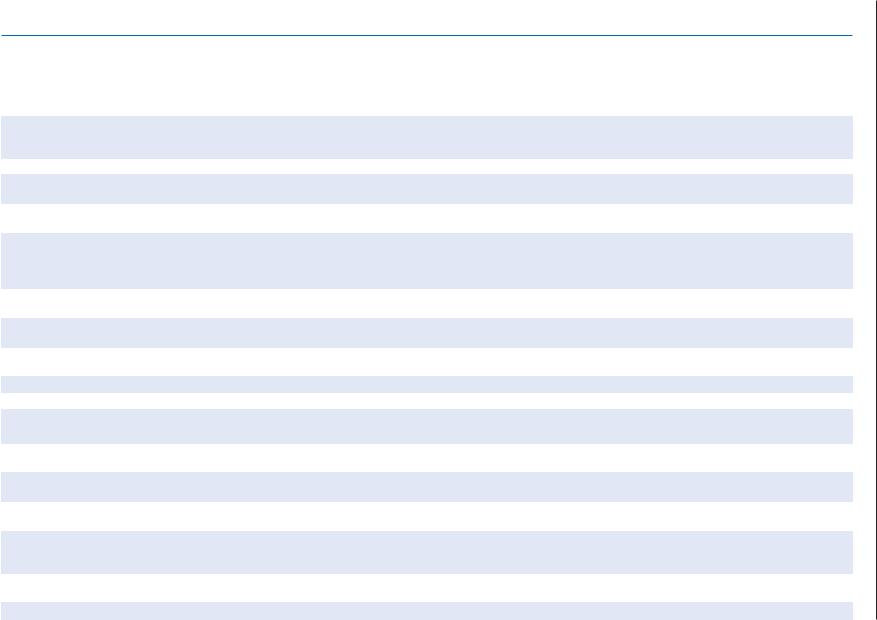
2013 OECD © – ECONOMIES EMERGING AND ADVANCED OTHER AND OECD ON INFORMATION COMPARATIVE 2013: ADMINISTRATION TAX
Table 9.7. Personal income tax. Employers’ withholding, payment, and reporting obligations (continued)
|
Employers’ withholding obligation – frequency and time when payable after liability period |
Regime type: |
Employers’ wage reporting obligation Frequency and time when reportable |
||
Country |
In general |
Special rules for prescribed small (S) |
Cumulative or |
In general |
Special rules for prescribed small (S) |
or large (L) employers, if any |
Non-cumulative |
or large (L) employers, if any |
|||
|
|
|
|
|
|
Japan |
Monthly – by 10th day of following month |
Semi-annually (s)-by 10th day after |
Cumulative |
Monthly – by 10th day of following month |
Semi-annually (s)-by 10th day after |
|
|
liability period |
|
|
liability period |
Korea |
Monthly – by 10th day of following month, |
Biannually: by 10th day of following |
Cumulative |
Monthly – by 10th day of following month |
Biannually: by 10th day of following |
|
|
month (pre-approved small |
|
|
month (approved small companies) |
|
|
companies) |
|
|
|
Luxembourg |
Monthly – by 10th day of following month |
|
Cumulative |
Annually |
|
Mexico/1 |
Monthly – by 17th day of following month |
Small employers: six monthly/1 |
Cumulative |
Annually – by 15th of February after the |
n.app. |
|
|
|
|
end of income year |
|
Netherlands |
Monthly – by last day of following month |
n.a. |
Non-cumulative |
Monthly – by last day of the following |
n.app. |
|
|
|
|
month |
|
New Zealand |
Monthly – by 20th day of following month |
(L)-twice monthly: by 20th of month |
Cumulative |
Monthly – by 5th of next month |
n.app. |
|
|
for payments made up to 15th day; |
|
|
|
|
|
by the 5th of following month for |
|
|
|
|
|
payments later in the month. |
|
|
|
Norway |
Bi-monthly – by 15th day following end of |
n.app. |
Non-cumulative |
Annually – by 31 January after end of |
n.app. |
|
bimonthly period |
|
|
income year |
|
Poland |
Monthly-within 21 days |
No |
Cumulative |
Annually – by end January (and by end |
No |
|
|
|
|
February to taxpayer) |
|
Portugal |
Monthly – by 20th of following month |
n.app. |
Non-cumulative |
Monthly – by 20th of next month and |
n.app. |
|
|
|
|
annually by end-February |
|
Slovak Rep. |
Monthly – by 5th of following month |
n.app. |
Cumulative/1 |
Monthly by the end of the next month |
n.app. |
Slovenia |
Monthly – by 10th of following month |
n.app. |
Non-cumulative |
Monthly – by 10th of following month |
n.app. |
Spain |
Quarterly – by 20th of following month |
Monthly (large companies)-by 20th |
Cumulative/1 |
Annually – by 31st January after end of |
Annually – by 20th January if the |
|
|
of following month |
|
income year |
pre-printed form is used |
Sweden |
Monthly – by 12th day of following month |
n.app. |
Non-cumulative |
Annually – by 31st January after end of |
n.app. |
|
|
|
|
income year |
|
Switzerland |
taxpayers----------------------------------------------------------------- |
Administered by sub-national cantons – No withholding for resident |
|
||
|
|
|
|
|
|
Turkey/1 |
Monthly – by 26th day of following month |
n.app. |
Cumulative |
Monthly – by 23th day of following month |
Quarterly (for small)-on 23rd day of |
|
|
|
|
|
January, April, July, October/1 |
United Kingdom |
Monthly/1-by 19th of following month |
Quarterly (optional for s): annually |
Cumulative |
Annually – by 19th may of following year |
n.app. |
|
|
– by 19th may of the following tax |
|
|
|
|
|
year |
|
|
|
United States/1 |
Monthly – by 15th day of following month |
(l) semi-weekly-(l) 3 business days |
Non-cumulative |
Quarterly – by last day of month following |
(s) annually-(s) by last day of the |
|
|
after date of payment/1 |
|
the end of the quarter |
month following the end of the year |
Non-OECD countries
ADMINISTRATION TAX FOR FRAMEWORKS ADMINISTRATIVE LEGISLATED .9 – 300
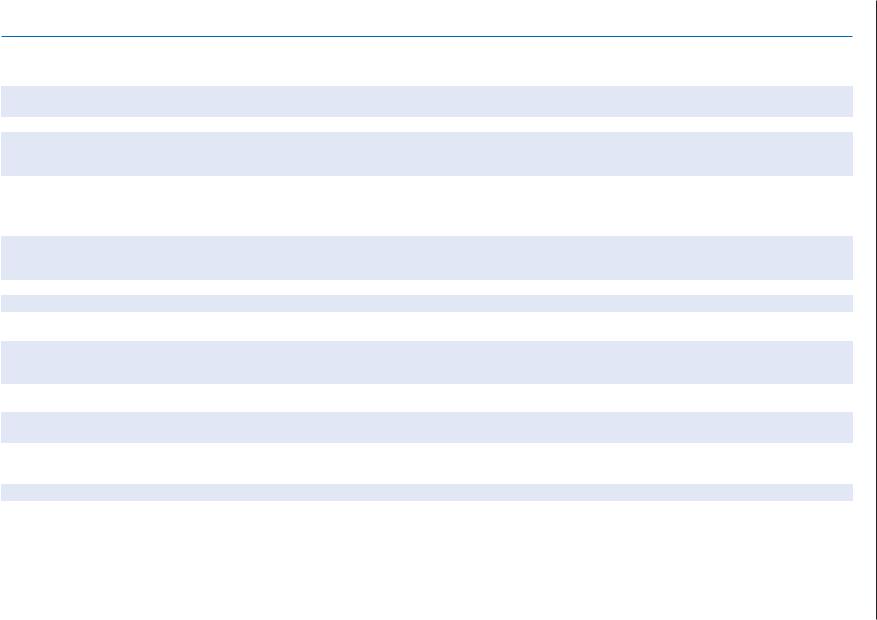
2013 OECD © – ECONOMIES EMERGING AND ADVANCED OTHER AND OECD ON INFORMATION COMPARATIVE 2013: ADMINISTRATION TAX
Table 9.7. Personal income tax. Employers’ withholding, payment, and reporting obligations (continued)
|
Employers’ withholding obligation – frequency and time when payable after liability period |
Regime type: |
Employers’ wage reporting obligation Frequency and time when reportable |
||
Country |
In general |
Special rules for prescribed small (S) |
Cumulative or |
In general |
Special rules for prescribed small (S) |
or large (L) employers, if any |
Non-cumulative |
or large (L) employers, if any |
|||
|
|
|
|
|
|
Argentina |
Monthly – by 10h day of following month |
Bi-annually if payment is less than |
Cumulative |
Monthly – by 10h day of following month |
n.app. |
|
|
ARS 2 000 |
|
|
|
Brazil |
|
|
Non-cumulative |
|
|
Bulgaria |
Monthly – by 10th day of the following |
n.app. |
Cumulative |
Monthly-not later than the day following |
n.app. |
|
month |
|
|
the day of paying the income for the |
|
|
|
|
|
respective month |
|
China |
Monthly – by 7th day of following month |
n.app. |
Cumulative |
Monthly – by 7th day of following month |
n.app. |
Colombia |
|
|
Cumulative |
|
|
Cyprus |
Monthly – by 30th day of following month |
n.app. |
Cumulative |
Annually – by end April after fiscal year; 3 |
n.app. |
|
|
|
|
month extension for electronic reports |
|
Hong Kong, China |
- |
- |
- |
Annually – within 1 month from the first |
- |
|
|
|
|
working day of April after end of fiscal year |
|
|
|
|
|
in March |
|
India |
n.a. |
n.a. |
Cumulative |
n.a. |
n.a. |
Indonesia |
Monthly – by 10th day of following month |
n.app. |
Cumulative |
Monthly, 20th day of following month |
n.appl. |
Latvia |
Day when employment income is paid |
Quarterly – by 15th day following |
Cumulative |
Monthly – by the date set by the revenue |
Quarterly-15 days after end of the |
|
|
end of quarter/1 |
|
body |
quarter/1 |
Lithuania |
By 15th day of month for wages paid in |
n.app. |
Non-cumulative |
Monthly returns by 15th day of following |
n.app. |
|
prior 15 days, and by end of month for |
|
|
month and quarterly by 15th day of the |
|
|
wages paid from 16th to end of month. |
|
|
second month of the following tax period. |
|
Malaysia |
Monthly – by 10th day of following month |
n.app. |
STD |
Annually – by 31st March after end of |
n.app. |
|
|
|
|
income year |
|
Malta |
Monthly – by end of following month |
n.app. |
Non-cumulative |
Annually – by 15 February after end of |
n.app. |
|
|
|
|
income year |
|
Romania |
Monthly – by 25th day of following month |
Small: quarterly and half-yearly |
Cumulative |
Monthly – by 25th day of following month; |
Quarterly and half-yearly – by 25th |
|
|
– by 25th day after end of liability |
|
Annually-28thday after end of income year |
day after end of reporting period |
|
|
period |
|
|
|
Russia |
n.a. |
n.a. |
Cumulative |
n.a. |
n.a. |
Saudi Arabia |
n.app. |
|
|
|
|
Singapore |
No withholding system on employee income except for temporary non-citizen employees/1 |
Annually – by 1 March |
/2 |
||
South Africa |
Monthly – by 7th day of following month |
n.app. |
Cumulative |
Mid-year reconciliation return due end- |
|
|
|
|
|
October. Year-end reconciliation return |
|
|
|
|
|
due end-May. |
|
For notes indicated by “/ (number)”, see Notes to Tables section at the end of the chapter, p. <?>.
Sources: IBFD, CIS survey responses, and country revenue officials.
301 – ADMINISTRATION TAX FOR FRAMEWORKS ADMINISTRATIVE LEGISLATED .9

302 – 9. LEGISLATED ADMINISTRATIVE FRAMEWORKS FOR TAX ADMINISTRATION
Collection of income taxes by advance/instalment payments of tax
In the absence of withholding, there is a need for an alternate approach to ensure a timely and appropriate flow of revenue into Government accounts. For this purpose, Governments have implemented systems of advance payments of tax for both the PIT and CIT.
The design on advance payment regimes for both the PIT and CIT is not a straightforward issue given a number of competing considerations. These include: 1) compliance burden: taxpayers should be able to readily determine their advance payments obligations and have a reasonable period of time to make payment; 2) revenue body workload and efficiency: the volume of payments and information to be processed by the revenue body should be minimised to avoid excessive costs; 3) payment compliance: excessive lagging of tax payments may jeopardise their ultimate collectability; 4) revenue management: government requirements for tax revenue to fund expenditure commitments; and 5) equity: taxpayers in similar circumstances should be treated equally.
Taking these sorts of factors into account, the vast majority of surveyed countries have evolved systems for the advanced collection of personal income and corporate profits taxes, the basic features of which are set out in Tables 9.8 and 9.9. The key observations are set out hereunder:
Personal income tax
With only one exception (i.e. Singapore), all countries provide for the graduated collection of PIT on income not subject to withholding (e.g. income of selfemployed persons) with a regime of advance/instalment payments; however the requirements of these arrangements vary substantially in terms of the number of payments to be made, the basis of their computation, and their timing.
Most countries aim to maximise the amount of tax collected by advance payment regimes within the year the relevant income is derived; typically, this is achieved with a regime of monthly and/or quarterly instalments to be made largely within the year of income; a number of revenue bodies apply thresholds in respect of relatively small liabilities to minimise the numbers of low value payment transactions.
There are a variety of bases used for the calculation of advance payments (e.g. proportion of prior year tax, proportion of estimated current year liability) reflecting, on the one hand, the objective of facilitating administration and, on the other, aligning the amount of tax paid to the income actually derived.
Compared to the arrangements prevailing in the vast majority of countries, a few countries (e.g. France, Singapore and United Kingdom) offer unusually generous periods within their legislative frameworks for making tax payments, resulting in considerable lags in tax collection.
At least 20% of revenue bodies appear to require monthly advance payments from taxpayers with relatively small liabilities, suggesting opportunities for reducing taxpayers’ compliance burden and reducing low value administrative workloads.
Many countries have aligned the requirements (e.g. timing and bases of computation) of their PIT (largely self-employed taxpayers) and CIT advance payment regimes.
TAX ADMINISTRATION 2013: COMPARATIVE INFORMATION ON OECD AND OTHER ADVANCED AND EMERGING ECONOMIES – © OECD 2013

9. LEGISLATED ADMINISTRATIVE FRAMEWORKS FOR TAX ADMINISTRATION – 303
Corporate income tax
With one exception (i.e. Singapore), all countries provide for the gradual collection of CIT with a regime of advance payments, although the requirements of these systems vary substantially in terms of the number of payments to be made, the basis of their computation, and the precise timing of individual payments (refer later comments).
Most countries aim to maximise the amount of tax collected by advance payment regimes within the year the relevant income is derived; typically, this is achieved with a regime of monthly (for large taxpayers) and quarterly (for small/medium sized taxpayers) advance payments to be made largely within the year of income.
A very small number of countries (e.g. Norway, Singapore, and United Kingdom) offer unusually generous periods within their legislative frameworks for making of tax payments, resulting in considerable lags in tax collection.
Administrative assessment and self-assessment regimes
Most non-European OECD countries have evolved their systems for the administration of income taxes to one based on self-assessment principles, as opposed to administrative assessment, which typically requires some level of examination of all/most returns by technical officials prior to issuing assessments to taxpayers. From the information in Tables 9.8 and 9.9, it can be seen that for the PIT, around half of OECD revenue bodies (18) apply self-assessment principles while for the CIT, the proportion is around two thirds (22). Countries not applying self assessment are exclusively from within Europe. The corresponding figures for non-OECD countries are slightly higher-for the PIT, 9 of 15 revenue bodies and for the CIT, 13 of 15 revenue bodies. The slightly higher proportions evident in non-OECD countries may be due to a number of factors (e.g. the more recent introduction of new tax regimes, and related efforts to enhance revenue mobilisation).
Generally speaking, the adoption of self assessment principles in the countries concerned reflects a desire to move away from in-house administrative assessment procedures in favor of more comprehensive and targeted approaches to providing help and assistance to taxpayers, and to the systemic verification of reported tax liabilities through risk-based desk and field audits and computerized matching of income reports. In countries where selfassessment has been adopted, it has generally been initiated with the objective of improving overall compliance with the laws and increasing operational efficiency by (1) the earlier collection of tax revenue; (2) streamlining the system of returns processing; and (3) reducing the incidence of disputed assessments. The data in Tables 9.8 and 9.9, along with data on dispute volumes in Tables 6.14 and 6.15 (Chapter 6), partially bear out these observations. Revenue bodies operating systems of assessment (as opposed to self-assessment) tend to report substantially and proportionally larger volumes of dispute cases, for example:
|
Administrative assessment applies |
Dispute volumes (finalised cases) |
||
Country |
PIT |
CIT |
2010 |
2011 |
Austria |
9 |
9 |
145 539 |
145 440 |
Denmark |
9 |
9 |
67 615 |
93 448 |
France |
9 |
x |
3 615 744 |
3 580 454 |
Germany |
9 |
9 |
5 252 592 |
4 149 543 |
Netherlands |
9 |
9 |
400 009 |
439 033 |
Norway |
9 |
9 |
64 572 |
82 270 |
TAX ADMINISTRATION 2013: COMPARATIVE INFORMATION ON OECD AND OTHER ADVANCED AND EMERGING ECONOMIES – © OECD 2013

304 – 9. LEGISLATED ADMINISTRATIVE FRAMEWORKS FOR TAX ADMINISTRATION
|
Administrative assessment applies |
Dispute volumes (finalised cases) |
||
Country |
PIT |
CIT |
2010 |
2011 |
|
|
|
|
|
Portugal |
9 |
9 |
52 684 |
49 756 |
Australia |
x |
x |
21 807 |
24 513 |
Japan |
x |
x |
7 590 |
8 463 |
Korea |
x |
x |
5 940 |
5 905 |
In those countries applying self assessment principles, the practice is generally to require the annual tax return earlier in the year after the year of income, and to seek payment of any residual tax due with the return when it is filed; by way of contrast, countries applying administrative assessment approaches tend to allow longer periods for return filing and any residual tax is due after assessment. On the other hand, it should also be recognised that some revenue bodies using systems of administrative assessment have largely automated their return processing operations and risk assessment procedures so that only a small proportion of tax returns are identified for technical scrutiny before a formal notice of assessment is sent to the taxpayer.
TAX ADMINISTRATION 2013: COMPARATIVE INFORMATION ON OECD AND OTHER ADVANCED AND EMERGING ECONOMIES – © OECD 2013
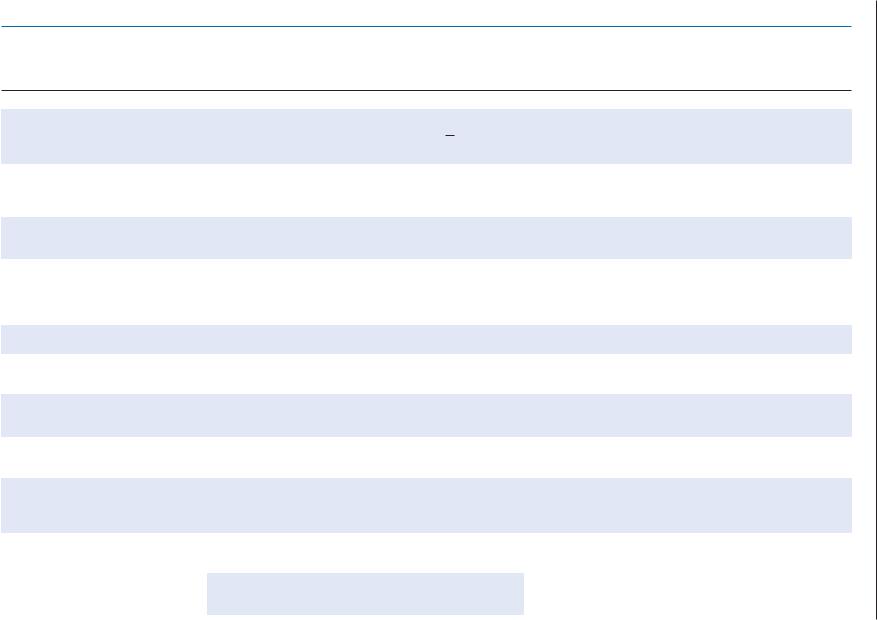
2013 OECD © – ECONOMIES EMERGING AND ADVANCED OTHER AND OECD ON INFORMATION COMPARATIVE 2013: ADMINISTRATION TAX
Table 9.8. Personal income tax: payment and return filing obligations
|
Advance payments of personal income tax (other than taxes withheld at source) |
Requirements for annual tax return |
|
||||
|
|
|
|
|
Time when is final |
Returns |
Returns are |
|
|
Frequency of payments and time |
|
Time when return due |
tax is due after end |
are self- |
required from |
Country |
Who is liable/1 |
when normally payable/2 |
Basis of payment computation |
after end of fiscal year/3 |
of fiscal period/3 |
assessed |
employees |
OECD countries
Australia |
All with income not taxed |
|
at source (small threshold |
|
applies) |
Austria |
Self-employed |
Belgium/4 |
Self-employed and other |
|
specified individuals |
Canada |
All with income not taxed |
|
or not sufficiently taxed at |
|
source (small threshold |
|
applies) |
Chile/4 |
Self-employed |
Czech Rep./4 |
All with income other than |
|
employment income |
Denmark |
All with income not taxed |
|
at source |
Estonia/4 |
Self-employed |
Finland |
All income not subject to |
|
withholding |
France |
All personal taxpayers |
|
(no withholding system, |
|
except employees’ social |
|
contributions) |
Quarterly (only in 3rd and 4th quarters for certain payers): 28 days after the end of each quarter of income year
Quarterly: by 15 February, May, August, and November of income year
Four (optional) – by 10 April, July, and October, and 22 December of income year
Quarterly: by 15 March, June, September and December of income year; annually for farmers and fishermen-by 31 December
Monthly: by 12th day of the following month/4
Small: 4 quarterly: by 15th day of 3rd, 6th, 9th, and 12th months of income year
Monthly (for 10 months): by 20th of each month: January-May, JulyNovember of income year
Three instalments: by 15th day of June, September, and December of income year
Monthly: by the 23rd day of each month in income year
Three payments: by 15th day of February, May and September of assessment year
Monthly over 10 months (optional)- from January To October of assessment year
Gross quarterly income x PY average tax rate or 25% of PY tax (+ GDP adjustment)
25% of the prior year’s tax plus adjustment factor
Determined by taxpayer
25% of PY tax, or CY estimate, or amount shown on reminder. Farmers and fishermen – 2/3 of PY tax.
10% of monthly receipts
1/12 (large) or ¼ (small) of prior year’s tax
10% of estimated tax ability
25% of PY tax
1/12 of the prior year’s tax or pro rated share of estimated current year’s tax
33.3% of PY tax
10% of PY tax
4 months (tax agents |
n.a. |
can file progressively up |
|
to 9 months) |
|
4 months (paper),
6 months (e-filed); extension possible if registered tax agent)
6 months
4 months (5 and a half months for selfemployed and their
spouse or common law partner
4 months
3 months (can be extended by 3 months if tax advisor used)
4 months (for pre-filled returns); 6 months for others
3 months
Varies for different types of taxpayers
5-6 months (business income earners)
One month after assessment issued
2 months after issue of
assessment notice. 4 months
4 months (with return)
Due with filing of return)
3 instalments – in Sept, Oct and Nov. After assessment
Varies/5
2 instalments, in December and February after assessment)
1 month after assessment issued From September to December of assessment year
99
x x
x 9
99
9x
x x
9(extensive
xuse of prefilled returns)
9(extensive 9 use of prefilled returns)
9(extensive
x |
use of pre- |
|
filled returns) |
x 9
305 – ADMINISTRATION TAX FOR FRAMEWORKS ADMINISTRATIVE LEGISLATED .9
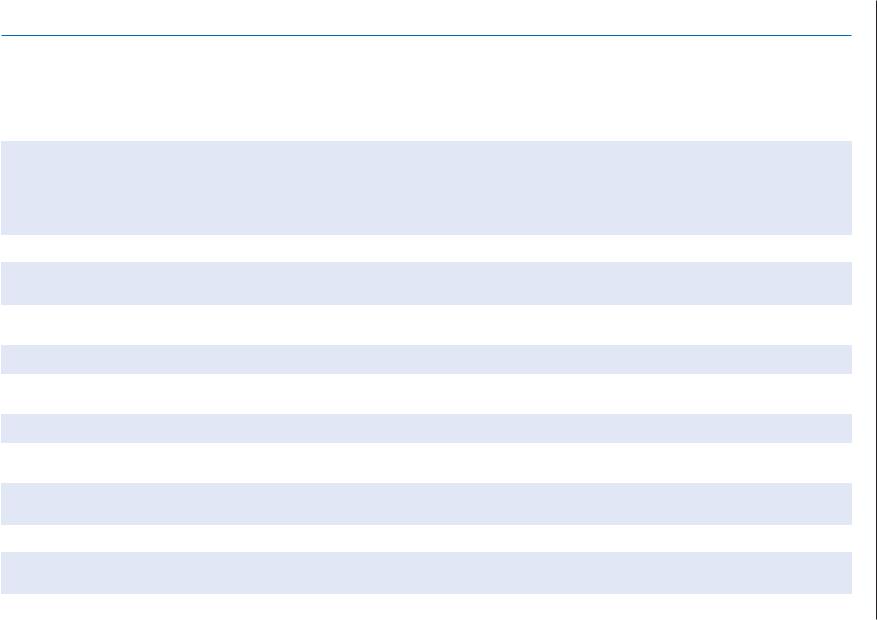
2013 OECD © – ECONOMIES EMERGING AND ADVANCED OTHER AND OECD ON INFORMATION COMPARATIVE 2013: ADMINISTRATION TAX
Table 9.8. Personal income tax: payment and return filing obligations (continued)
|
Advance payments of personal income tax (other than taxes withheld at source) |
Requirements for annual tax return |
|
|||||
|
|
|
|
|
|
Time when is final |
Returns |
Returns are |
|
|
Frequency of payments and time |
|
Time when return due |
tax is due after end |
are self- |
required from |
|
Country |
Who is liable/1 |
when normally payable/2 |
Basis of payment computation |
after end of fiscal year/3 |
of fiscal period/3 |
assessed |
employees |
|
|
|
|
|
|
|
|
|
|
Germany |
All taxpayers with income |
Quarterly; Mar 10, June 10, Sept |
Tax return of the previous year |
5 months |
One month after |
x |
Only under |
|
|
not subject to a withholding |
10, Dec 10 |
|
|
|
disclosure of tax |
certain |
|
|
|
|
|
|
||||
|
tax |
|
|
|
|
assessment notice |
|
conditions |
Greece |
Individuals |
Three equal be monthly instalments |
The withholding tax is assessed |
Generally, 2 months |
Since the time of |
|
|
|
|
|
or lump-sum payment with a 1.5% |
along with the income tax, and |
after end of fiscal year/5 |
the clearance of |
|
|
|
|
|
deduction of the paid tax. |
calculated at 55% of the tax |
|
the tax return, the |
|
|
|
|
|
|
|
resulting from the confirmatory |
|
due tax is payable |
x |
9 |
|
|
|
|
titles, after subtracting any |
|
and shall be |
|
|
|
|
|
|
withholding at source or prepaid |
|
charged. |
|
|
|
|
|
|
taxes/4 |
|
|
|
|
Hungary |
All with income not taxed |
Monthly: by 12th day following end of |
Pro-rated share of estimated |
4 months and 20 days |
Until 20. May (with |
9 |
9 |
|
|
at source |
each month |
|
current tax |
|
return) |
||
Iceland |
All with income not taxed |
Monthly |
1 February To |
Monthly-10.5% of previous year’s |
3 months |
Over 5 months |
|
9 (extensive |
|
at source |
|
June |
tax |
|
(August/ |
x |
use of pre- |
|
|
|
|
|
|
December) |
|
filled returns) |
Ireland |
Taxpayers with income not |
Annually: by 31 October of income |
90% of final tax due for |
10 months |
Due with filing of |
|
|
|
|
taxed at source |
year |
|
accounting period or 100% of final |
|
return |
9 |
x |
|
|
|
|
tax due for preceding fiscal period |
|
|
|
|
Israel |
Self-employed |
Monthly |
Italy |
All taxpayers, not subject |
Annually – by 16 June and |
|
to withholding (small |
30 November of income year |
|
threshold) |
|
Japan |
All (threshold applies) |
Bi-annually: by 31 July and |
|
|
30 November of income year |
Korea |
All with business and rental |
One advance payment-by |
|
income |
30 November of income year |
Luxembourg |
All with income not taxed |
Quarterly: by 10 March, June, |
|
at source |
September, December of income |
|
|
year |
Mexico |
All individuals not subject |
Monthly: by 17th day after end of |
|
to withholding |
relevant month |
Netherlands |
All with income not taxed |
Monthly-progressively each month |
|
at source |
following receipt of assessment |
|
|
notice for prior year’s income |
February-November: 10% of prior |
4 months |
30 April (with |
9 |
x |
year tax. |
|
return) |
||
|
|
|
||
39 6% and 56 4% of prior year’s |
7 months (9 months for |
5 months and 16 |
|
|
tax (small threshold applies) |
e-filed return) |
days |
9 |
x |
1/3 of prior year tax payable (with |
2 months and 15 days |
2 months and 15 |
9 |
x |
some adjustments) |
|
days (with return) |
||
|
|
|
||
½ of tax paid or payable for the |
5 months |
5 months (due with |
|
|
previous year plus any penalty |
|
return) |
9 |
x |
tax/1 |
|
|
|
|
¼ of prior year tax year |
3 months (in practice it |
1 month after tax |
|
|
|
may be extended) |
assessment |
x |
x |
Generally net income of the |
4 months |
30 April (with |
9 |
9/4 |
period times tax rate |
|
return) |
||
|
|
|
||
Based on prior year’s tax (plus |
3 months (may be |
2 months after |
|
|
inflation factor) / number of |
extended) |
assessment notice |
x |
9 |
months remaining in income year |
|
issued |
|
|
ADMINISTRATION TAX FOR FRAMEWORKS ADMINISTRATIVE LEGISLATED .9 – 306
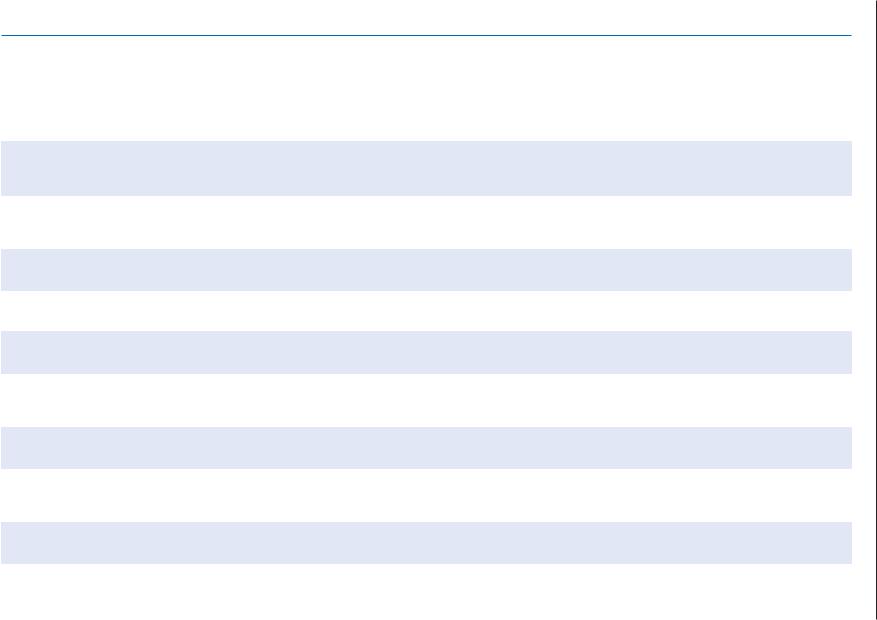
2013 OECD © – ECONOMIES EMERGING AND ADVANCED OTHER AND OECD ON INFORMATION COMPARATIVE 2013: ADMINISTRATION TAX
Table 9.8. Personal income tax: payment and return filing obligations (continued)
|
Advance payments of personal income tax (other than taxes withheld at source) |
Requirements for annual tax return |
|
||||
|
|
|
|
|
Time when is final |
Returns |
Returns are |
|
|
Frequency of payments and time |
|
Time when return due |
tax is due after end |
are self- |
required from |
Country |
Who is liable/1 |
when normally payable/2 |
Basis of payment computation |
after end of fiscal year/3 |
of fiscal period/3 |
assessed |
employees |
|
|
|
|
|
|
|
|
New Zealand |
All with income not taxed at |
Trimester (3)-by 7 April, August, and |
1/3 of 105 of prior year tax |
158 or 188 days |
37 days after |
|
|
|
source (threshold applies) |
December of income year |
payable |
depending on income |
month of balance |
9 |
x |
|
|
|
|
source |
day |
|
|
Norway |
All with income not taxed |
Quarterly: by 15 March, May, |
Prior year assessment and the tax |
1 month |
Two payments – 3 |
|
|
|
at source |
September, and November of |
rates for the coming year |
|
and 8 weeks after |
x |
9 |
|
|
income year |
|
|
assessment notice |
||
|
|
|
|
|
|
||
|
|
|
|
|
issued |
|
|
Poland |
All taxpayers in business. |
12 monthly payments – by the 20th |
19% or based on progressive |
4 months |
With return |
|
|
|
Taxpayers who receive |
day of the following month |
rates of income tax (i.e. 18% or |
|
|
9 |
(Generally) |
|
income from rental or lease |
Quarterly: by the 20th day of the |
30%) |
|
|
9 |
|
month following end of the quarter
Portugal/4 |
Self-employed, |
|
professionals businessmen |
|
and farmers |
Slovak Rep. |
All individuals with income |
|
not subject to withholding |
|
(threshold applies) |
Slovenia |
Sole entrepreneurs |
Spain/4 Self-employed professionals and businessmen
Sweden |
Income from business |
Three payments-by 20th of July, September, and December of income year
Monthly for large taxpayers and quarterly for small: by the end of each month or quarter
Monthly and quarterly (for small taxpayers): by 10 days after end of liability period
Quarterly, by 20th April, July, October of the income year and by 31st January of the following year.
Monthly: from February of income year, generally between 12th and 17th of month.
76.5% of the tax payable for the year two years prior to the income year
1/12 of PY tax, or 25% of prior year tax for small taxpayers
1/12 (1/4) of PY tax assessed
Varies for different classes of taxpayers (professionals,
businessmen under a flat rate scheme)
Between 105%-110% of prior year final tax
Switzerland |
Tax payment requirements vary across individual cantons. In general, all taxpayers must make advance |
|
payments and there is no tax withholding on employment income, other than for non-residents). |
Varies by type of taxpayer, and service of delivery/1
3 months / can be extended by tree or six months in certain cases
5 months
In May and June of the following year.
4 months
Varies by type of
taxpayer – August x to September
3 calendar months
after end of fiscal 9 x year
Within 1 month of the notice advising liability
May and June of the following year (due with filing of the return).
90 days after assessment notice issued.
9(extensive
xuse of prefilled returns)
9(extensive 9 use of prefilled returns)
9(extensive
x |
use of pre- |
|
filled returns) |
Tax return requirements (and associated tax payment requirements) vary across individual cantons. Generally speaking, all returns are subject to administrative assessment. There is provision for electronic filing in some cantons.
Turkey |
Persons with business and |
Quarterly: by 17th day of the second |
15% of actual income during |
Simple regime-1 month |
|
professional income |
month following the quarter |
income period |
and 25 days; others-2 |
|
|
|
|
months and 25 days |
United |
Taxpayers with income not |
Bi-annual: by 31 January of income |
50% of prior year’s tax |
6 months where liability |
Kingdom |
taxed at source |
year, and 31 July of following year |
|
not self-calculated: 10 |
|
|
(tax year runs 6 April to 5 April) |
|
months where taxpayer |
|
|
|
|
self-calculate |
With return (and with provision for instalments)
10 months approx. (by 31 January after the tax year)
9x
9x
307 – ADMINISTRATION TAX FOR FRAMEWORKS ADMINISTRATIVE LEGISLATED .9
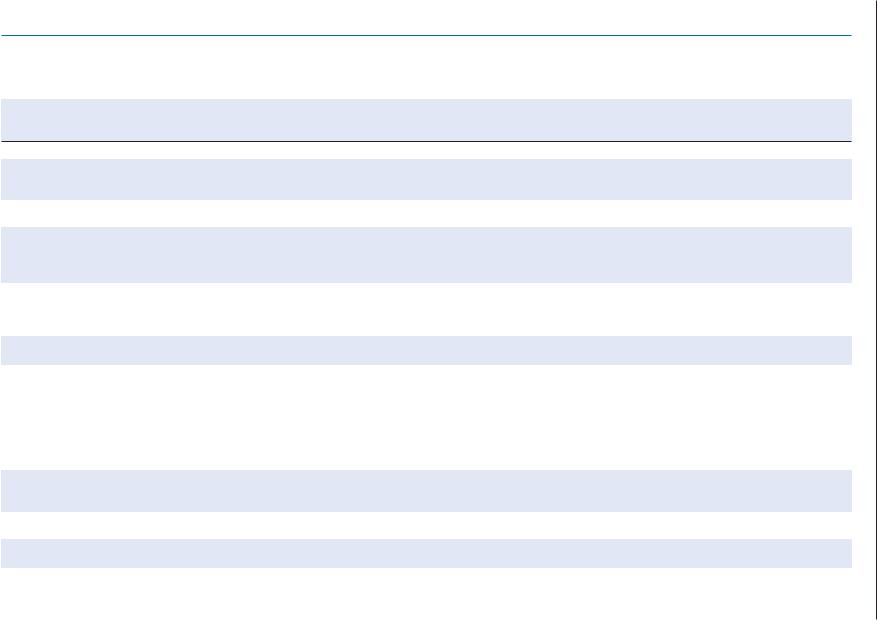
2013 OECD © – ECONOMIES EMERGING AND ADVANCED OTHER AND OECD ON INFORMATION COMPARATIVE 2013: ADMINISTRATION TAX
Table 9.8. Personal income tax: payment and return filing obligations (continued)
|
Advance payments of personal income tax (other than taxes withheld at source) |
Requirements for annual tax return |
|
||||
|
|
|
|
|
Time when is final |
Returns |
Returns are |
|
|
Frequency of payments and time |
|
Time when return due |
tax is due after end |
are self- |
required from |
Country |
Who is liable/1 |
when normally payable/2 |
Basis of payment computation |
after end of fiscal year/3 |
of fiscal period/3 |
assessed |
employees |
|
|
|
|
|
|
|
|
United |
All with income not taxed |
Quarterly: by 15 days of month |
25% of the lesser of (i) 90% of |
3 months and 15 days |
Final payment due |
9 |
9 |
States/4 |
at source |
following end of the quarter |
estimated current year tax; or |
|
with return |
|
|
(ii) 100% of prior year tax
Non-OECD countries
Argentina |
All with income not taxed |
|
source (who reported tax |
|
assessed over threshold |
Brazil |
All with income not taxed at |
|
source |
Bulgaria |
All taxpayers with income |
|
not subject to withholding |
|
tax/1 |
China |
All with income not taxed at |
|
source |
Colombia |
All with income not taxed at |
|
source |
Cyprus |
All with income other than |
|
emoluments |
Hong Kong, |
Taxpayers subject to |
China |
salaries tax |
India |
All with income not taxed at |
|
source |
Indonesia |
Entrepreneurs |
Latvia |
Self-employed |
5 instalments – by June, August, |
20% of prior year tax |
In April and May |
Day following |
October and December of income |
|
(depending on tax id) |
the return filing |
year, and following February |
|
|
deadline |
Monthly |
% of net income |
4 months |
With return |
Three quarterly payments-by the |
The taxable quarterly income |
4 months |
4 months |
15th day of the month following the |
– the mandatory social security |
|
|
quarter income was received (but |
contributions for period x 10% |
|
|
not for final quarter) |
|
|
|
Monthly: by 7th day of following |
Varies according to the nature of |
3 months (business |
3 months |
month |
income |
income and income |
(business income |
|
|
earned abroad); |
and income earned |
|
|
|
abroad) |
Large – five instalments |
% of PY tax |
Varies according to TIN |
Varies |
Other – two instalments |
|
of taxpayer |
|
Three instalments-by 1 August, |
Equal instalments of estimated |
4, 6 or 12 months |
End of next |
30 September, and 31 December |
tax on taxable income. |
(Extension of 3 months |
month after issue |
of income year. (Different dates for |
|
where e-filed, which is |
of assessment |
long term insurance businesses) |
|
compulsory from July |
(employees); |
(As from 2013 installments reduced |
|
2011 where turnover |
6 months (income< |
to 2, 31st July and 31st December) |
|
exceeds EUR 70 000 |
70 000), and |
|
|
|
7 months (income |
|
|
|
>70 000) |
Two instalments of provisional |
% of PY tax |
One month after receipt |
As advised in |
tax – 75% in January and 25% 3 |
|
from IRD |
assessment notice |
months later |
|
|
|
Three-by 15th day of September, |
30% of advance due x 2, |
5 months, 6 months if |
|
December and March |
remainder in final payment |
accounts audited |
|
Monthly: by 15 th day of following |
75% of gross monthly turnover |
3 months |
Before return is |
month |
|
|
filed |
Quarterly: by 15 March, 15th May, |
¼ of either prior year“s tax or |
01.03-01.06 |
15 days after filling |
15th August and 15th November of |
estimated current year tax |
|
returns/1 |
income year |
|
|
|
9x/4
9x
9x
9x
9x
9(except for
employee) 9
x9
xx
9x
9x
ADMINISTRATION TAX FOR FRAMEWORKS ADMINISTRATIVE LEGISLATED .9 – 308
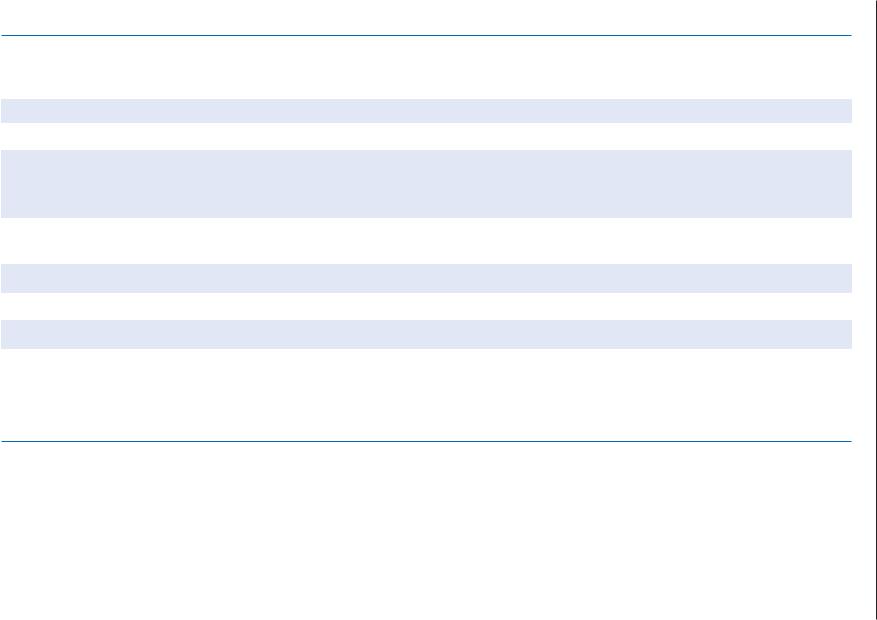
2013 OECD © – ECONOMIES EMERGING AND ADVANCED OTHER AND OECD ON INFORMATION COMPARATIVE 2013: ADMINISTRATION TAX
Table 9.8. Personal income tax: payment and return filing obligations (continued)
|
Advance payments of personal income tax (other than taxes withheld at source) |
Requirements for annual tax return |
|
||||
|
|
|
|
|
Time when is final |
Returns |
Returns are |
|
|
Frequency of payments and time |
|
Time when return due |
tax is due after end |
are self- |
required from |
Country |
Who is liable/1 |
when normally payable/2 |
Basis of payment computation |
after end of fiscal year/3 |
of fiscal period/3 |
assessed |
employees |
|
|
|
|
|
|
|
|
Lithuania/4 |
No general system of advance payments is applied |
|
4 months |
With return |
9 |
x |
|
Malaysia |
Self-employed |
Bi-monthly |
Previous year’s tax liability |
Employees by 30 April; |
On filing due date |
9 |
9 |
|
|
|
|
others by 30 June |
|
||
Malta |
All with income not taxed at |
Three payments-by end-April, |
20%, 30%, and 50% respectively |
6 months |
With return |
|
Only if in |
|
source |
August, and December of income |
of PY assessed tax |
|
|
|
receipt of |
|
|
year |
|
|
|
9 |
other income |
|
|
|
|
|
|
|
not taxed at |
Romania |
Taxpayers with income |
Quarterly: by the 15th day of the |
25% of tax payable on estimated |
4 months and 25 days |
With return |
|
source |
|
|
||||||
|
from independent activities |
month after each quarter |
current year income or prior year |
|
|
x |
x |
|
or rents |
|
income |
|
|
|
|
Russia |
Individual entrepreneurs |
Three-by 15th day of July, October |
50% and 25% of tax payable on |
4 months |
15 July |
x |
x |
|
and professionals |
and January |
estimated liability |
|
|
||
|
|
|
|
|
|||
Saudi Arabia |
Individual entrepreneurs |
Three-by end of June, September |
25% of prior year tax |
4 months |
With return |
x |
x |
|
and professionals |
and December of income year |
|
|
|
||
|
|
|
|
|
|
||
Singapore |
No general system of advance payments applies |
|
South Africa |
All with income other than |
Two payments-by end-August and |
|
salaries and wages |
February of income year (tax year |
|
|
is 1 March to end February) |
1st: ½ of PY assessed tax or estimated CY liability; 2nd: Large taxpayers: Balance to reach at least 80% of estimated CY liability. SMEs: Balance to reach at least 100% of PY assessed tax or 90% of CY liability.
15th April (paper); 18th |
Within 1 month of |
x |
9/4 |
|
April (e-file). |
assessment notice. |
|||
|
|
|||
6 months after income |
7 months after end |
|
|
|
year for paper files and |
of income year |
|
|
|
9 months after income |
|
|
|
|
year for e-filed returns |
|
x |
x/4 |
For notes indicated by “/ (number)”, see Notes to Tables section at the end of the chapter, p. 343. PY = previous year, CY = current year, FY = following year, SME = small and medium enterprises Sources: IBFD, CIS survey responses, and country revenue officials.
309 – ADMINISTRATION TAX FOR FRAMEWORKS ADMINISTRATIVE LEGISLATED .9
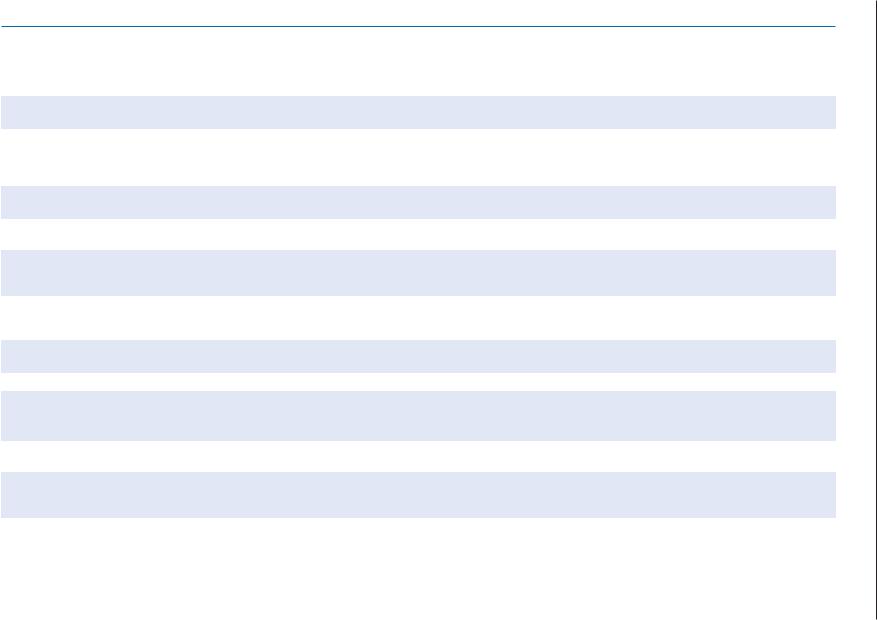
2013 OECD © – ECONOMIES EMERGING AND ADVANCED OTHER AND OECD ON INFORMATION COMPARATIVE 2013: ADMINISTRATION TAX
Table 9.9. Corporate Income Tax: Payment and return filing obligations
|
|
|
Advance payments of corporate income tax |
Annual corporate income tax return |
|||
|
|
|
|
|
Time return due after |
When final tax is |
Returns are |
Country |
Who is liable/1 |
Frequency of payments and when payable/2 |
Basis of payment computation |
end of year |
normally due/3 |
self-assessed |
|
|
|
|
|
|
|
|
|
OECD countries |
|
|
|
|
|
|
|
Australia |
All taxpayers |
Quarterly – by 28 days after end of each quarter of |
Quarterly income x PY average tax rate |
6 months and 15 days |
With return |
9 |
|
|
|
(small threshold) |
income year |
|
|
|
|
Austria |
All |
Quarterly – by 15 February, May, August, and November |
25% of prior assessment plus |
4 months (paper), |
One month after |
x |
|
|
|
|
of income year |
adjustment factor |
6 months (e-filed); |
assessment |
|
|
|
|
|
|
extension possible for |
|
|
|
|
|
|
|
registered tax agents |
|
|
Belgium/4 |
All |
Quarterly: by the 10th of the fourth, seventh and tenth |
|
|
month and the 20th of last month of accounting period. |
Canada |
All |
Monthly – by end of each month in income year |
Chile |
All enterprises |
Monthly – by the 12th day of the following month (by |
|
|
20th day of the following month if using electronic |
|
|
invoices and internet to declare and pay the tax) |
Czech Rep. |
All (small |
Bi-annually: 30 000 CZK<tax liability< 150 000 CZK); |
|
threshold) |
quarterly (tax liability >150 000czk)-by 15th of last month |
|
|
of the period |
Denmark |
All |
Two payments-by 20 March and November of income |
|
|
year |
Estonia/4 |
/4 |
|
Finland |
All |
Large: Monthly |
|
|
Small liabilities-two, in March and September of income |
|
|
year |
25% of estimated liability |
Date indicated on tax |
Two months after |
x |
|
return |
assessment |
|
1/12 of PY tax, or estimated current |
6 months |
2/3 months after |
9 |
year’s liability |
|
year end |
|
Fixed % of monthly receipts, |
4 months |
With filing of |
3 |
recalculated yearly on the basis of the |
|
return |
|
% of the prior year/4 |
|
|
|
Proportion of PY tax of the period |
3 months (6 if |
With return |
9 |
|
chartered accountant |
|
|
|
used) |
|
|
50% of average tax paid in three prior |
6 months |
10 months after |
x/4 |
years |
|
income year end |
|
|
n.a. |
n.a. |
9 |
1/12 of estimated liability |
4 months |
11 months after |
x |
Pro-rated share of estimated liability |
|
end of tax year |
|
|
|
|
France |
All (very low |
Quarterly – by 15 March, June, September, And |
¼ of PY corporate tax due |
4 months |
With return |
9 |
|
threshold applies) |
December of year of income |
|
|
|
|
Germany/4 |
All with taxable |
4/quarterly – by 10 March, June, September and |
¼ of PY tax; CY estimate where tax |
5 months |
1 month after |
x |
|
income |
December of income year |
office has information on expected |
|
assessment |
|
|
|
|
relevant difference to PY’s income |
|
|
|
Greece |
The legal entities The tax is paid in eight (8) equal monthly installments. In |
|
case of a full payment there is a 1.5% tax deduction of |
|
the paid tax. |
The withholding tax is assessed along |
4½ months. For |
At the time of the |
x |
with the income tax, and calculated |
partnerships, |
submission of the |
|
at 80% of the tax or 100% for bank |
there are different |
tax return. |
|
companies or 55% for partnerships. |
deadlines, based on |
|
|
|
specific conditions. |
|
|
ADMINISTRATION TAX FOR FRAMEWORKS ADMINISTRATIVE LEGISLATED .9 – 310
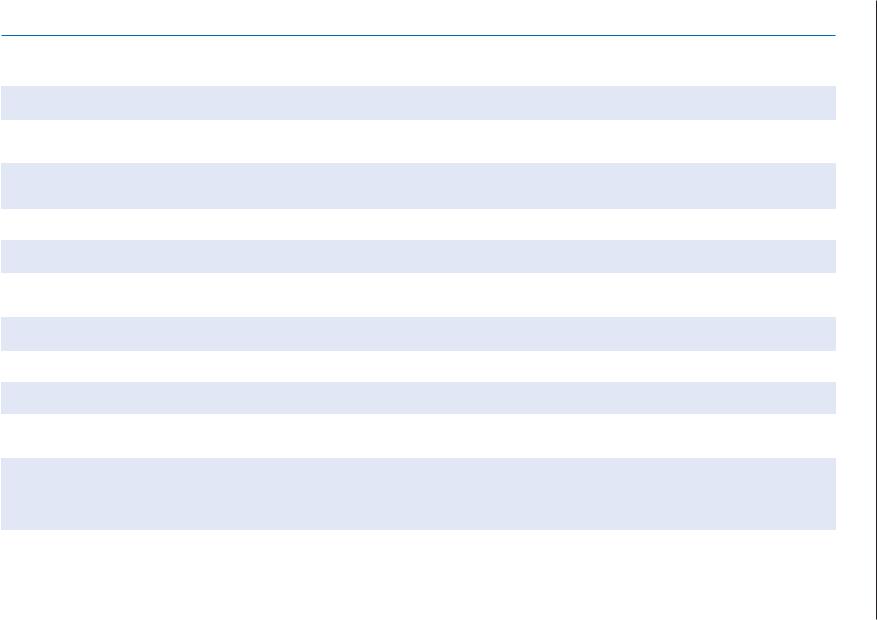
2013 OECD © – ECONOMIES EMERGING AND ADVANCED OTHER AND OECD ON INFORMATION COMPARATIVE 2013: ADMINISTRATION TAX
Table 9.9. Corporate Income Tax: Payment and return filing obligations (continued)
|
|
Advance payments of corporate income tax |
Annual corporate income tax return |
|||
|
|
|
|
Time return due after |
When final tax is |
Returns are |
Country |
Who is liable/1 |
Frequency of payments and when payable/2 |
Basis of payment computation |
end of year |
normally due/3 |
self-assessed |
|
|
|
|
|
|
|
Hungary |
All |
Monthly – if PY tax amount > 5 million HUF |
Prorated proportion of PY tax |
5 months |
With return |
9 |
|
|
Quarterly – if PY tax amount < 5 million HUF |
|
|
|
|
Iceland |
All |
Ten monthly payments-from 1st day of each month |
Monthly-10.5% of PY tax |
5 months |
2 instalments |
x |
|
|
commencing in June of income year |
|
|
(last 2 months of |
|
|
|
|
|
|
assessment year |
|
Ireland/4 |
All companies |
Differing treatments depending on the size of the |
1st-50% of PY tax or 45% of CY |
9 months |
9 months |
9 |
|
except those in |
company/4 |
estimate; 2nd-to reach 90% of CY |
|
|
|
|
first year of trading |
|
estimated tax |
|
|
|
Israel |
All |
Monthly |
Monthly |
5 months |
5 months (with |
9 |
|
|
|
|
|
return) |
|
Italy |
All |
Two payments – by the 6th and the 11th month of income |
First 40% of PY liability; second: 60% of |
9 month |
By 6th month of |
3 |
|
|
year |
PY liability |
|
following year |
|
Japan |
All taxpayers |
One payment-by the end of the 8th month in the income |
50% of PY liability (or cy liability if |
2 months (extension |
2 months (with |
9 |
|
(small threshold |
year |
interim return filed |
can be requested) |
return) |
|
|
applies) |
|
|
|
|
|
Korea |
All Corporation |
One Payment – 8 Months into the year(for annual filers) |
Luxembourg |
All |
Quarterly – by 10 March, June, September, And |
|
|
December of income year |
Mexico |
All |
Monthly – by 17th day after end of relevant month |
Netherlands |
All |
Up to twelve monthly payments – progressively each |
|
|
month following receipt of assessment notice for prior |
|
|
year’s income. |
New Zealand |
All taxpayers |
Three payments-by 7 July, November, and March of |
|
(small threshold |
income year (1 April to 31 March). |
|
applies) |
|
Norway |
Petroleum |
Six payments – by 1st of August and December in |
|
producers and |
income year. By 1st of February, April and June in |
|
transporters |
assessment year. |
|
Others |
Two payments-by 15th day of February and April in |
|
|
assessment year |
50% of PY liability or CY liability if interim return filed)
25% of PY liability
Estimated CY liability
Average of two prior year’s tax (plus inflation factor) / no. of months left in income year
1/3 of PY tax plus 5% or 1/3 of estimated tax.
100% of estimated liability
3 months |
3 months(with |
3 |
|
return) |
|
5 months (extension |
One month after |
x |
possible) |
assessment |
|
3 months |
3 months (with |
9 |
|
return) |
|
5 months (extension |
Two months after |
x |
can be requested) |
receipt of official |
|
|
assessment. |
|
3 months and 7 days |
14 months where |
9 |
|
extension of |
|
|
time is given; |
|
|
interest applies to |
|
|
residual tax. |
|
5 months (e-filers |
3 weeks after |
x |
and 3 months (others) |
assessment |
|
(extra 1 month on |
notice issued |
|
application) |
|
|
311 – ADMINISTRATION TAX FOR FRAMEWORKS ADMINISTRATIVE LEGISLATED .9
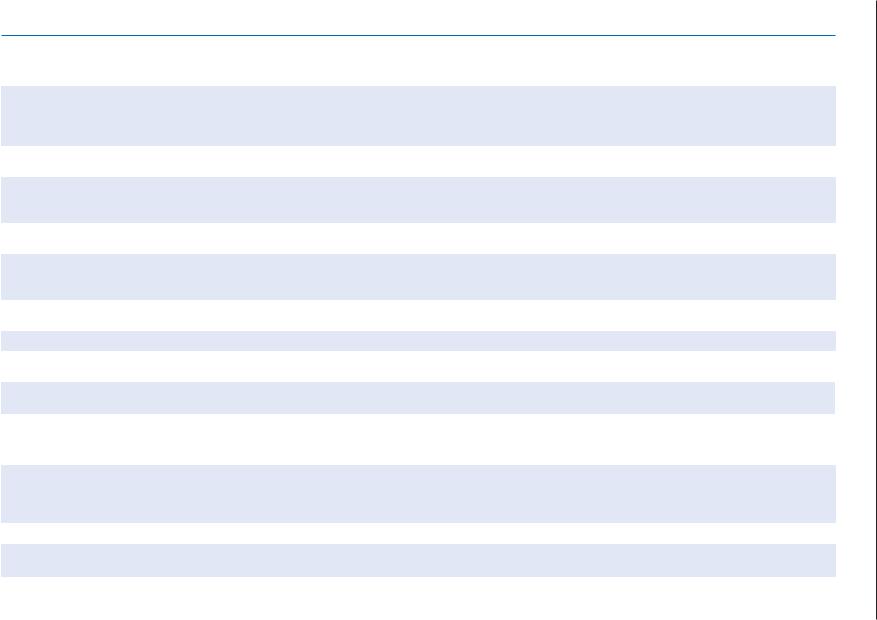
2013 OECD © – ECONOMIES EMERGING AND ADVANCED OTHER AND OECD ON INFORMATION COMPARATIVE 2013: ADMINISTRATION TAX
Table 9.9. Corporate Income Tax: Payment and return filing obligations (continued)
|
|
Advance payments of corporate income tax |
Annual corporate income tax return |
|||
|
|
|
|
Time return due after |
When final tax is |
Returns are |
Country |
Who is liable/1 |
Frequency of payments and when payable/2 |
Basis of payment computation |
end of year |
normally due/3 |
self-assessed |
|
|
|
|
|
|
|
Poland |
Taxpayer |
Monthly or quarterly (for small taxpayers and for start- |
Difference between tax due on the |
Until the end of third |
Until the end of |
3 |
|
|
ups) paid to the 20th day of the month following the |
income obtained since the beginning of |
month after the end |
third month after |
|
|
|
advance payment period (month/quarter) |
the tax year and the sum of advanced |
of the tax year |
the end of the tax |
|
|
|
|
payments due for the previous months |
|
year |
|
Portugal |
All/1 |
Three payments by July, September, and December of |
Large: 90% of PY liability; others: 70% |
5 months |
5 months |
|
|
|
income year |
of PY liability |
|
|
|
Slovak Rep. |
All legal entities |
12 monthly (large); 4 quarterly (others)-at the end of |
Large: 1/12 of PY liability; small: ¼ of |
3 months (period |
3 months |
9 |
|
(over prescribed |
each liability period |
PY liability |
can be extended in |
|
|
|
threshold) |
|
|
certain cases) |
|
|
Slovenia |
All |
12 monthly (large) and 4 quarterly (others): within 10 |
1/12 (monthly payers) and ¼ (others) of |
3 months |
4 months |
9 |
|
|
days of end of liability period |
PY tax |
|
|
|
Spain |
All legal entities |
Three payments – by 20th April, October and December |
Large: progressive of CY estimated |
6 months and 25 |
6 months and |
9 |
|
|
of the income year |
liability; others: of the PY liability |
days after end of |
25 days (with |
|
|
|
|
|
fiscal period. |
return) |
|
Sweden |
All |
12 monthly – within each month of income year |
Based on preliminary return filed in |
4 months |
Within 90 days of |
x |
|
|
|
December before income year |
|
notice |
|
Switzerland |
Tax collection arrangements vary across individual cantons. |
|
|
|
|
|
Turkey |
All |
Quarterly – by 17th day of the second month following |
20 % of actual income during income |
3 months and 25 days |
3 months and 30 |
9 |
|
|
the quarter |
period |
|
days |
|
United |
Large (with profit |
Four payments – due in the 7th, 10th 13th, and 16th months |
¼ of estimated tax liability |
12 months |
Nine months after |
9 |
Kingdom |
> GDP 1.5 m) |
after the income year |
|
|
end of income year. |
|
United |
All |
Four quarterly payments – by the 15th day of 4th, 6th, 9th, |
Generally, ¼ of either estimated CY tax |
2 months and 15 days |
2 months and 15 |
9 |
States/4 |
|
and 12th months of the corporation’s tax year |
or PY tax |
|
days (with return) |
|
Non-OECD countries |
|
|
|
|
|
|
Argentina |
All legal entities |
10 monthly payments-from 6th month after accounting |
1st payment-25% of PY liability; others- |
5 months |
Following day |
9 |
|
(threshold |
year, and thereafter monthly. |
8.33% of PY tax |
|
of the due date |
|
|
applies) |
|
|
|
for the tax return |
|
|
|
|
|
|
filing. |
|
Brazil |
|
|
|
|
|
|
Bulgaria |
All taxpayers |
12 monthly (large); or 3 quarterly payments, except 4th quarter |
1/12 of PY tax liability or based on CY |
3 months |
3 months (with |
9 |
|
|
(others): by 15th day of month after end of liability period |
income in period 2/ |
|
return) |
|
China |
All enterprises |
4 quarterly payments-within 15 days of end of each quarter |
¼ of prior year tax, or tax on actual |
1 month and 15 days |
4 months |
9 |
|
|
|
quarterly profits |
|
|
|
ADMINISTRATION TAX FOR FRAMEWORKS ADMINISTRATIVE LEGISLATED .9 – 312
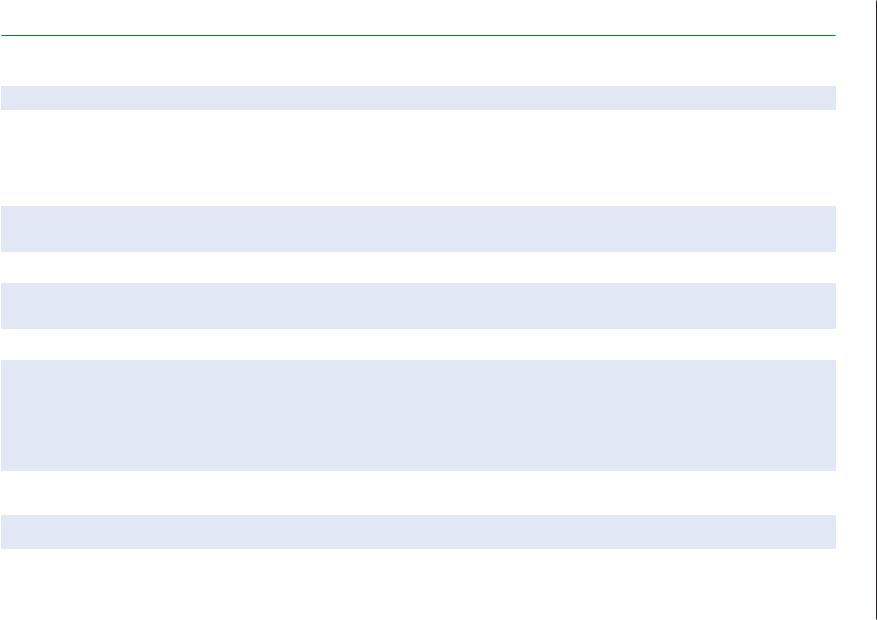
2013 OECD © – ECONOMIES EMERGING AND ADVANCED OTHER AND OECD ON INFORMATION COMPARATIVE 2013: ADMINISTRATION TAX
Table 9.9. Corporate Income Tax: Payment and return filing obligations (continued)
|
|
Advance payments of corporate income tax |
Annual corporate income tax return |
|||
|
|
|
|
Time return due after |
When final tax is |
Returns are |
Country |
Who is liable/1 |
Frequency of payments and when payable/2 |
Basis of payment computation |
end of year |
normally due/3 |
self-assessed |
|
|
|
|
|
|
|
Colombia |
|
|
|
|
|
|
Cyprus |
All companies |
Three payments – by 1 August, 30 September, and |
Equal instalments of estimated tax on |
31 December following |
1 August |
9 |
|
|
31 December of income year |
CY taxable income |
year of assessment. |
following year of |
|
|
|
(As from 2013 installments reduced to 2, 31st July and |
|
Date extended by 3 |
assessment |
|
|
|
31st December)/4 |
|
months if submission |
|
|
|
|
|
|
electronic. as from |
|
|
|
|
|
|
1.7.2011 submission is |
|
|
|
|
|
|
electronic |
|
|
Hong Kong, |
All |
Two instalments of provisional tax – 75% and 25% |
China |
|
|
India |
All (small |
Four payments: by the 15th day of June, September, |
|
threshold applies) |
December and March of income year (i.e.1 April to 31 March) |
Indonesia |
All |
12 monthly payments-by the 15th of the day of each |
|
|
month in the income year |
Latvia |
All |
12 monthly payments-by 15th day of each month |
Lithuania |
Entities with PY |
Advance corporate income tax must be paid by the last |
|
taxable income |
day of each quarter of the tax period, while the advance |
|
exceeding |
corporate income tax for the last quarter of the tax |
|
LTL 1 million). |
period must be paid by the 25th day of the last month of |
|
Newly registered |
the said quarter |
|
entities exempt |
|
|
during the first |
|
|
fiscal year |
|
Malaysia |
All companies |
Monthly and beginning of the month |
Malta |
All |
Three payments-by end-April, August, and December of |
|
|
income year |
Romania |
All corporations |
Four quarterly payments-by 25th day of month following |
|
and prescribed |
liability period |
|
others/4 |
|
PY assessed tax
Payments to reach 15%, 45%, 75% and 100% of estimated CY tax
1/12 of PY tax
Based on PY tax; adjustment for CPI movements
Advance corporate income tax payments are calculated either based on the taxable income of the previous year or on the anticipated amount of corporate income tax for the current tax period
Estimation by taxpayer; not less than 85% of the previous year’s tax liability
20%, 30%, and 50% respectively of PY assessed tax
¼ of PY tax (updated for inflation) or quarterly CY income x tax rate
Returns sent to taxpayers in April; required within a month
6 months
4 months (2 month extension on application)
Large: 7 months; others 4 months
First day of sixth month of the next tax period
End of the 7th month after accounting year ends
9 months
3 months and 15 days
As advised in |
x |
assessment |
|
notice |
|
n.a. |
9 |
4 months (with |
9 |
return) |
|
15 days after |
9 |
receipt of notice |
|
First day of tenth |
3 |
month of the |
|
next tax period |
|
On filing due |
3 |
date |
|
With return |
3 |
3 months and |
9 |
15 days (with |
|
return |
|
313 – ADMINISTRATION TAX FOR FRAMEWORKS ADMINISTRATIVE LEGISLATED .9
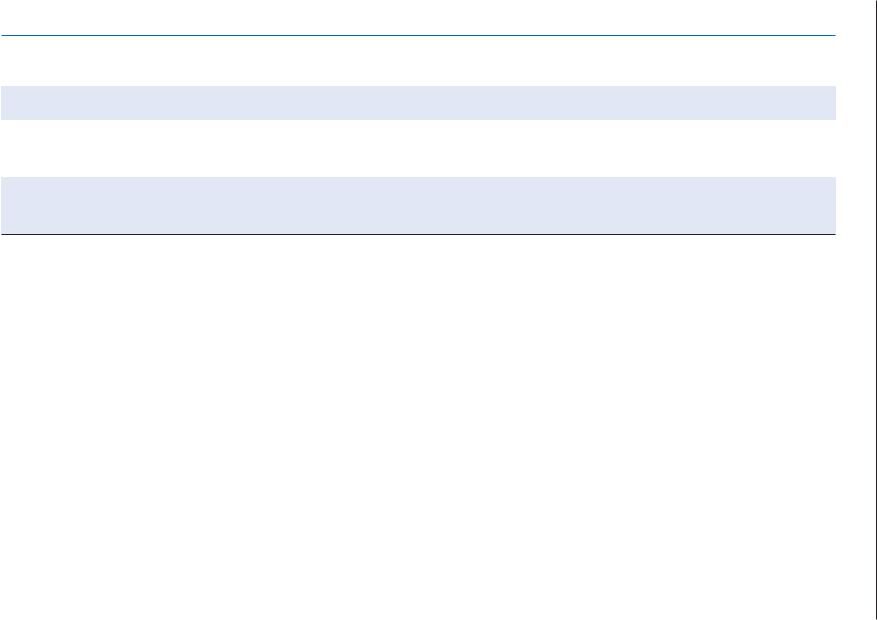
2013 OECD © – ECONOMIES EMERGING AND ADVANCED OTHER AND OECD ON INFORMATION COMPARATIVE 2013: ADMINISTRATION TAX
Table 9.9. Corporate Income Tax: Payment and return filing obligations (continued)
|
|
Advance payments of corporate income tax |
Annual corporate income tax return |
|||
|
|
|
|
Time return due after |
When final tax is |
Returns are |
Country |
Who is liable/1 |
Frequency of payments and when payable/2 |
Basis of payment computation |
end of year |
normally due/3 |
self-assessed |
|
|
|
|
|
|
|
Russia |
All |
12 monthly payments (large) and four quarterly |
Large-1/3 of estimated tax payable for |
3 months |
n.a. |
9 |
|
|
payments (others) |
prior quarter |
|
|
|
Saudi Arabia |
Taxpayers with |
Three advance payments of tax on or prior to the last |
25% x (taxpayer’s tax for the preceding |
|
tax liability over |
day of the 6th, 9th, and 12th months of the taxable year. |
year minus the amount of tax paid in the |
|
2 million in prior |
|
preceding year by withholding). |
|
year |
|
|
Singapore Companies are required to file their estimated chargeable income (ECI) within 3 months from the end of their accounting year. They are required to pay the tax within 1 month from the date of notice of assessment. They may also arrange to pay their current year ECI by instalments.
Within 120 days after |
With return, |
9 |
the end of the taxable |
within 120 days |
|
year. |
after the end of |
|
|
the taxable year. |
|
30th November of the |
Within 1 month |
x |
following year/4 |
from the date |
|
|
of assessment |
|
|
notice. |
|
South Africa |
All |
Two 6 monthly payments-by 6th and 12th months of |
1st: ½ of PY assessed tax or estimated |
12 months after end |
6 months after |
x |
|
|
income year |
CY liability; 2nd: Large taxpayers: |
of income year. |
income year |
|
|
|
|
Balance to reach at least 80% of |
|
(7 months for |
|
|
|
|
estimated CY liability. SMEs: Balance to |
|
February year |
|
|
|
|
reach at least 100% of PY assessed tax |
|
ends). |
|
|
|
|
or 90% of CY liability. |
|
|
|
|
|
|
|
|
|
|
PY = previous year, CY = current year, FY = following year, SME = small and medium enterprises.
For notes indicated by “/ (number)”, see Notes to Tables section at the end of the chapter, p. 344.
Sources: IBFD, CIS survey responses and revenue officials.
ADMINISTRATION TAX FOR FRAMEWORKS ADMINISTRATIVE LEGISLATED .9 – 314
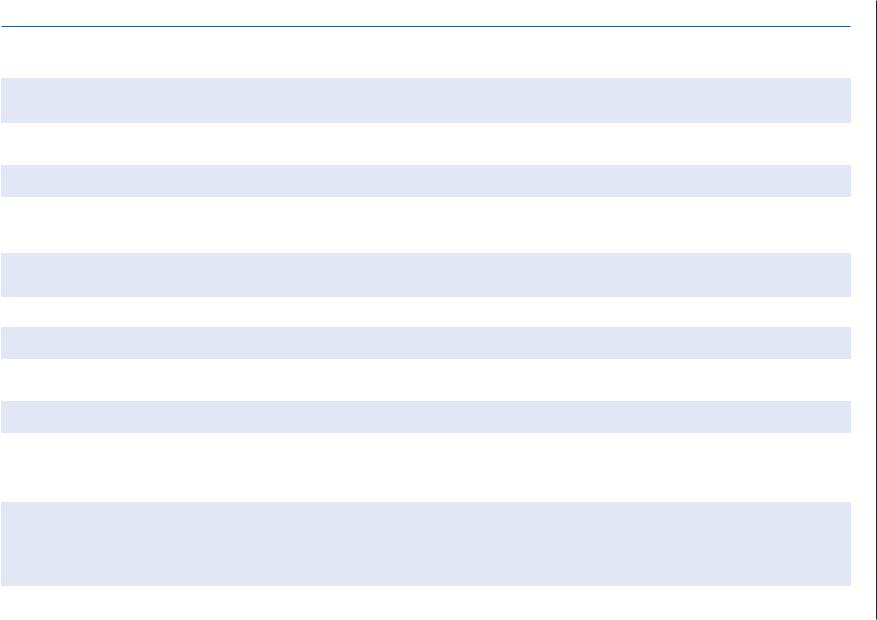
2013 OECD © – ECONOMIES EMERGING AND ADVANCED OTHER AND OECD ON INFORMATION COMPARATIVE 2013: ADMINISTRATION TAX
Table 9.10. Value Added Tax (VAT): Registration, payment, and filing obligations
|
|
Liability basis (e.g, accruals, cash |
Normal return filing and tax payment obligations (i.e. frequency and |
|
Country |
Registration threshold/1 |
or special) |
period to file and pay after end of liability period)/2-3 |
Special filing requirements/4 |
|
|
|
|
|
OECD countries |
|
|
|
|
Australia |
AUD 75 000 |
Accruals (cash basis allowed |
Large: monthly within 28 days; SMEs: quarterly within 28 days; very |
All business tax obligations are reported |
|
(AUD 150 000 for non- |
for businesses with turnover < |
small-annually within 28 days |
in a single business activity statement |
|
profit entities) |
AUD 2 million) |
|
filed monthly, quarterly or annually. |
Austria |
EUR 30 000 |
Accruals (cash basis allowed for |
Large: monthly within 45 days; SMEs: quarterly within 45 days |
Annual return required by end of April |
|
|
certain types of small businesses) |
|
of following year (paper) or end of June |
|
|
|
|
(e-filed) |
Belgium/5 |
EUR 5 580 |
Canada |
CDN USD 30 000 |
Accruals (with cash basis under specific conditions, flat rate scheme)/5
Accruals (with quick method scheme for prescribed traders with turnover < CDN USD 200 000)
Chile |
Zero |
Accrual basis |
Large and certain prescribed businesses: monthly within 20 days; others: quarterly return (with monthly instalments) within 20 days.
Large businesses (annual taxable supplies >USD 6 million): monthly within 30 days; Small Businesses (supplies over USD 1.5 million): quarterly within 30 days; very small businesses: annually within 30 to 166 days (167 days in leap years)
Monthly within 12 days of end of month, and within 20 days if using electronic invoices and internet.
Annual sales listing to all registered purchasers required
Some business sectors have specific reporting requirements. Mandatory e-filing for payers with sales >
USD 1.5 m
Large taxpayers are required to file sworn statements of purchases and sales, biannually.
Czech Rep. |
CZK 1 million (in last 12 |
|
months) |
Denmark |
DKK 50 000 |
Estonia |
EEK 250 000 |
Accruals
Accruals
Accruals (special schemes for travel agents, lumber sales, and 2nd hand goods
Finland |
EUR 8 500 |
Accruals |
France/5 |
EUR 81 500 |
Accruals (simplified scheme for |
|
(EUR 32 600 for |
prescribed businesses, turnover |
|
suppliers of services) |
thresholds apply)/5 |
Germany |
EUR 17 500 PY turnover |
Accruals (cash basis permitted in |
|
and EUR 50 000 CY |
certain cases, e.g. prior year turnover |
|
expected turnover |
not exceeding EUR 500 000) |
Large (i.e. turnover in PY year > CZK 10 million-monthly within 25 days; small-quarterly within 25 days
Large: monthly within 25 days; SMEs: quarterly within 40 days; very small-half yearly within 2 months
Monthly within 20 days
Large and SMEs monthly by 7th or 12th following month. Primary producers and artists annually
Large: monthly within 15/24 days; SMEs: quarterly within 15/24 days;
Return filing: quarterly (generally), annually if previous year’s tax does not exceed EUR 1 000; monthly if previous years’ tax does exceed EUR 7 500). Payment: within 10 day after the end of the return filling period
-
All regular tax obligations reported in single statement
-
-
Under simplified scheme, 4 instalments (based on PY tax in fiscal year) and an annual tax return to be filed by endApril. Businesses with turnover over EUR 230 000 must e-file returns
Annual return filling required from all taxable persons (monthly or quarterly fillings are provisional advance returns); taxable persons starting their business have to file monthly in the first and a second calendar year
315 – ADMINISTRATION TAX FOR FRAMEWORKS ADMINISTRATIVE LEGISLATED .9

2013 OECD © – ECONOMIES EMERGING AND ADVANCED OTHER AND OECD ON INFORMATION COMPARATIVE 2013: ADMINISTRATION TAX
Table 9.10. Value Added Tax (VAT): Registration, payment, and filing obligations (continued)
|
|
Liability basis (e.g, accruals, cash |
Normal return filing and tax payment obligations (i.e. frequency and |
|
Country |
Registration threshold/1 |
or special) |
period to file and pay after end of liability period)/2-3 |
Special filing requirements/4 |
Greece |
10 000 euro |
Accruals (flat-rate scheme for certain |
|
5 000 euro (for suppliers |
business categories e.g. fishing) |
|
of services only)/1 |
|
Depending on the type of bookkeeping, filing and payment obligations are monthly for C category and every three months for B category. The filing is done till the 26th of the next month of the liability period. All taxable persons submit annually 1 clearance tax return.
Taxable persons carrying out non taxable transactions submit a special return when a taxable transaction is taking place and VAT is due (e.g. intraCommunity acquisition by a doctor)
Hungary |
Zero |
Accruals |
UHIXQGDEOHLI±4XDUWHUO\+8)PLOOLRQ9UHIXQGDEOHLI±0RQWKO\$7 |
- |
|
|
|
PLOOLRQ9UHIXQGDEOHLI±$+8)PLOOLRQ9$7QQXDOO\$7 |
|
|
|
|
HUF. All within 20 days following liability period |
|
Iceland |
ISK 1 million |
Accruals |
Generally bi-monthly within 35 days; farmers: twice a year, very small |
not applicable |
|
|
|
payers: annually |
|
Ireland |
(EUR 70 000) (suppliers Cash basis for retailers and traders |
Bi-monthly within 19 days |
Annual return of trading details required |
|
|
of goods), EUR 35 000 |
with turnover < EUR 1 million. Retailers |
|
from all payers |
|
(suppliers of services) |
can use apportionment scheme where |
|
|
|
|
sales are at multiple rates. Flat rate |
|
|
|
|
scheme for prescribed businesses |
|
|
Israel |
Zero |
Accruals |
Large: monthly within 15 days; others-bi-monthly within 15 days |
- |
Italy |
Zero |
Various schemes for range of |
Monthly – within 35 days |
Annual consolidated return (multiple |
|
|
prescribed business categories |
|
taxes) required from all payers. |
Japan/5 |
JPY 10 million |
Accruals |
Large: monthly; medium-quarterly; Small: half-yearly; and very Small: |
When taxpayers file notification for |
|
|
|
annually, all within 2 months from end of taxable period/1 |
election of special exception for taxable |
|
|
|
|
period, they can file and pay more |
|
|
|
|
frequently than normal. |
Korea |
Zero |
Accruals |
Corporates: Quarterly within 25 days. |
|
|
|
|
,QGLYLGXDOV.Â/DUJHEXVLQHVVHV3<WXUQRYHU! 5:PLOOLRQ |
|
quarterly within 25 days; Small businesses (PY turnover |
- |
<KRW 48 million): half-yearly within 25 days |
|
Luxembourg |
EUR 10 000 |
Accruals |
Large: monthly within 15 days; SMEs: quarterly within 15 days; very |
|
|
|
small-annually |
Mexico |
Zero |
Cash flow basis |
Monthly within 17 days; primary producers may opt for half-yearly |
|
|
|
frequency for withholding payment obligation |
Netherlands |
Zero |
On application, traders including |
Large: monthly within 30 days; SMEs: quarterly within 30 days; very |
|
|
certain retailers may use simplified |
small traders-annually |
|
|
method. |
|
Annual return required from all taxpayers
-
Quarterly payment and filing for all entrepreneurs (a measure to ease burden on business from the economic crisis.)
New Zealand |
NZD 60 000 |
Use of cash or cash/accruals by small |
Large: monthly-within 30 days; SMEs: bi-monthly within 30 days, and |
- |
|
|
businesses |
very small payers-6 monthly |
|
|
|
|
ADMINISTRATION TAX FOR FRAMEWORKS ADMINISTRATIVE LEGISLATED .9 – 316
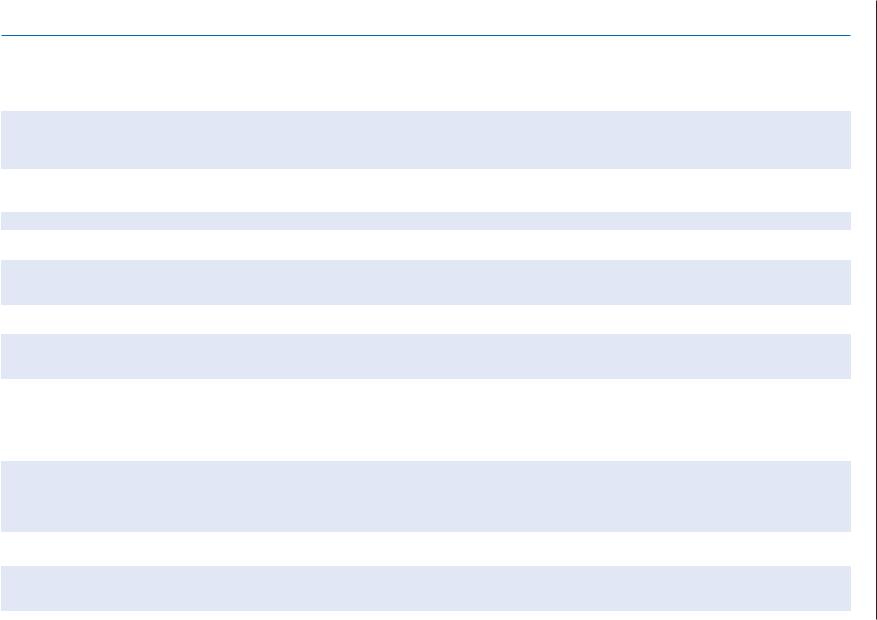
2013 OECD © – ECONOMIES EMERGING AND ADVANCED OTHER AND OECD ON INFORMATION COMPARATIVE 2013: ADMINISTRATION TAX
Table 9.10. Value Added Tax (VAT): Registration, payment, and filing obligations (continued)
|
|
Liability basis (e.g, accruals, cash |
Normal return filing and tax payment obligations (i.e. frequency and |
|
Country |
Registration threshold/1 |
or special) |
period to file and pay after end of liability period)/2-3 |
Special filing requirements/4 |
|
|
|
|
|
Norway |
NOK 50 000 |
Accruals |
Bi-monthly-within 40 days (except 3rd term, within 51 days); yearly for |
Monthly for traders who normally file |
|
|
|
traders with turnover < NOK 1 million within 70 days and farmers – |
returns for refunding vat (exporters). |
|
|
|
within 100 days |
|
Poland |
PLN 150 000 |
Accruals (cash accounting scheme |
Monthly within 25 days or quarterly within 25 days; for large when they |
|
|
is possible for small taxable |
choose quarterly returns – monthly advance payments |
|
|
persons (i.e. annual turnover is |
|
|
|
<EUR 1.2 million) |
|
Portugal |
Zero |
Accruals. Special flat rate scheme for |
Large: monthly within 40 days; Others: quarterly – within 45 days |
|
|
small retailers |
|
-
Annual consolidated return required from taxpayers obliged to keep accounting books
Slovak Rep. |
EUR 49 790 |
Accruals |
Large: monthly within 25 days; Others: quarterly within 25 days |
-. |
Slovenia |
EUR 25 000 |
Accruals or cash |
Large: monthly within 30 days; Others: quarterly within 30 days |
New taxpayers have to fill the |
|
|
|
|
statements monthly (for the first year) |
Spain |
Zero |
Accruals. (simple scheme for some |
|
|
professionals/business-men with flat |
|
|
rates calculated using specific indices). |
Sweden |
Zero |
Accruals |
Switzerland |
100 000 |
Accruals (cash basis where |
|
|
requested). Flat rate scheme for |
|
|
prescribed traders |
Large companies and taxpayers registered in the monthly refund register: monthly within 20 days; Others: quarterly within 20 days
Large: monthly within 26 days; SMEs: quarterly within 42 days; Very Small: annually (but tax paid as preliminary tax during fiscal year)
Large: monthly; SMEs: quarterly; and Very Small: half-yearly; all within 60 days
Annual return required from all taxpayers by 31st January of the following year.
Some very small traders can declare vat in annual income tax return
-
Turkey |
Zero |
Accruals |
Large: Return filling: by the 24th day of the month following the |
|
|
|
|
taxation period (monthly); Payment: by the 26th day of the tax return |
|
|
|
|
submitting month (monthly). |
-. |
|
|
|
Others: Return filling – by the 24th day of the month following the |
|
|
|
|
|
|
|
|
|
taxation period (quarterly); Payment: by the 26th day of the tax return |
|
|
|
|
submitting month (quarterly) |
|
United |
GDP 77 000 |
Accruals (cash basis for businesses |
Kingdom |
|
with turnover below GDP 1.35 m; |
|
|
special flat rate schemes for farmers |
|
|
and for businesses with turnover below |
|
|
GDP 150 000). |
Generally quarterly, due 1 month and 7 days after the accounting period; monthly returns may be allowed for repayment businesses;
businesses with turnover below GDP 1.35 m may file one annual - return (and make either 3 quarterly or nine monthly instalment
payments and a balancing payment at the year-end).
United States |
------------------------------------------------------------------------------------------------- |
|
No national VAT ------------------------------------------------------------------------------------------------- |
|
Non-OECD countries |
|
|
|
|
Argentina |
ARS 300 000 (supply of |
Accruals (special lump sum scheme (i. |
The payment of Monotributo must be made by the 20th day of each |
Monotributo taxpayers must file every |
|
goods); ARS 200 000 |
e. Monotributo*) for small businesses |
month. |
four months |
|
(supply of services) |
for VAT and income tax |
|
|
317 – ADMINISTRATION TAX FOR FRAMEWORKS ADMINISTRATIVE LEGISLATED .9
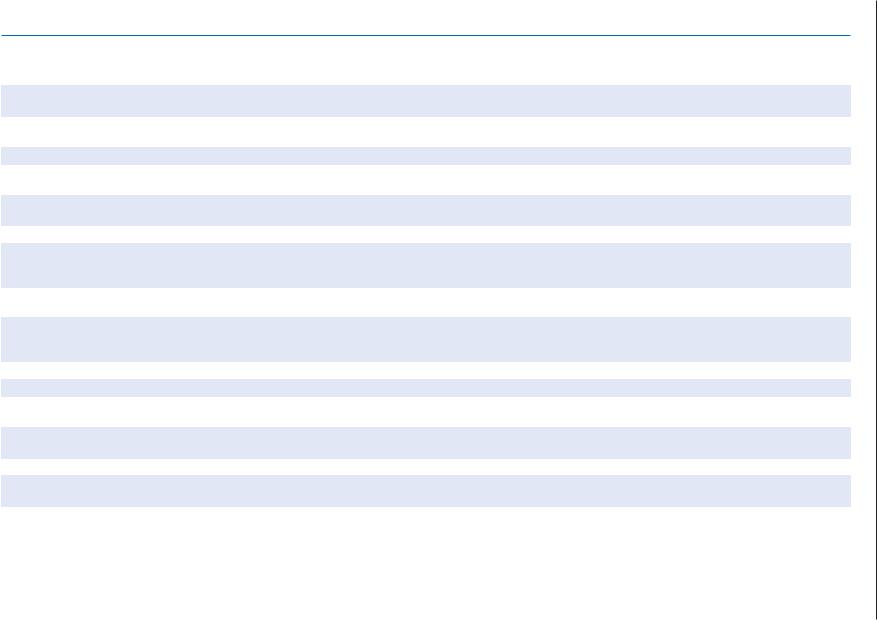
2013 OECD © – ECONOMIES EMERGING AND ADVANCED OTHER AND OECD ON INFORMATION COMPARATIVE 2013: ADMINISTRATION TAX
Table 9.10. Value Added Tax (VAT): Registration, payment, and filing obligations (continued)
|
|
Liability basis (e.g, accruals, cash |
Normal return filing and tax payment obligations (i.e. frequency and |
|
Country |
Registration threshold/1 |
or special) |
period to file and pay after end of liability period)/2-3 |
Special filing requirements/4 |
|
|
|
|
|
Brazil |
------------------------------------------------------------------------------------------------- |
|
No national VAT ------------------------------------------------------------------------------------------------- |
|
Bulgaria |
Bgn 50 000 |
Accumulations (monetary basis for |
Monthly within 14 days. |
-. |
|
(EUR 25 600). |
calculation) |
|
|
China |
Various/6 |
Accruals (small traders pay flat % of |
Within 1 3, 5 10, 15 days or monthly, depending on size of business |
Various |
|
|
turnover) |
|
|
Colombia |
|
|
|
|
Cyprus |
EUR 15 600 |
Accruals (with special scheme for |
Quarterly – within 10 days of second month after liability month |
Quarterly (annually permitted for |
|
|
farmers and retailers) |
|
farmers) |
Hong Kong, |
|
|
No national VAT |
|
China |
------------------------------------------------------------------------------------------------- |
|
|
|
|
|
|
|
|
India |
------------------------------------------------------------------------------------------------- |
|
No national VAT ------------------------------------------------------------------------------------------------- |
|
Indonesia |
IDR 600 000 (small |
Accruals |
Monthly, no later than the end of the subsequent month after the end |
|
|
entrepreneurs and |
|
of taxable period |
- |
|
professionals only) |
|
|
|
Latvia |
LVL 35 000 |
Accruals |
Large: monthly, medium size – quarterly, small – half yearly; all within |
VAT annual return required only if |
|
|
|
15 days (or 20 days where e-filed) |
certain conditions are met |
Lithuania |
155 000 (in the last 12 |
Accruals (with cash accounting |
For legal persons – monthly within 25 days; for natural persons – half- |
Annual VAT return might be required if |
|
months) |
possibility for persons supplying |
yearly within 25 days. |
certain conditions are met. |
|
|
agricultural products) |
|
|
Malaysia |
------------------------------------------------------------------------------------------------- |
|
No national VAT ------------------------------------------------------------------------------------------------- |
|
Malta |
EUR 7 000 |
Accruals and cash |
Monthly, quarterly, annual/ 45 days payment obligation |
|
Romania |
EUR 35 000 |
Accruals |
Large: monthly, within 25 days; SME – quarterly, within 25 days; |
- |
|
|
|
Others (as per law) – half yearly or annually |
|
Russia |
RUR 2 million (in 3 |
Accruals |
Quarterly within 20 days |
- |
|
preceding months) |
|
|
|
|
|
|
|
|
Saudi Arabia |
------------------------------------------------------------------------------------------------- |
|
No national VAT ------------------------------------------------------------------------------------------------- |
|
Singapore |
SGD 1 million |
Accruals |
Quarterly, with provision of monthly and half-yearly. Filing and |
All GST-registered businesses are |
|
|
|
payment within 1 month. |
required to e-file their returns. |
South Africa |
ZAR 1 million |
Accruals (cash basis for individuals |
Large: monthly within 25 days; SMEs: bi-monthly within 25 days; |
Electronic filing – due date for payment |
|
|
with turnover < ZAR 2.5 million) |
others-four-monthly/5 |
and filing last business day of month |
For notes indicated by “/ (number)”, see Notes to Tables section at the end of the chapter, p. 345.
Sources: IBFD, European Commission summaries of EU Member VAT Arrangements and revenue officials.
ADMINISTRATION TAX FOR FRAMEWORKS ADMINISTRATIVE LEGISLATED .9 – 318

9. LEGISLATED ADMINISTRATIVE FRAMEWORKS FOR TAX ADMINISTRATION – 319
Collection of VAT
As evident from the tax revenue data reported in Chapter 6, VAT constitutes a significant source of tax revenue in just about all surveyed countries. Of the countries surveyed, only Hong Kong, India, Malaysia, Saudi Arabia and the United States do not administer a VAT as part of their system of indirect taxation.
Given the significant and growing reliance being placed on VAT systems it is not surprising that the compliance burden resulting from their application has come under a fair deal of scrutiny, by Governments, revenue bodies and the business community at large. Over recent years, a number of studies have been conducted pointing to the nature and scale of the compliance burden that can result from the policy and administrative design features of a country’s VAT system.
The FTA report Programs to reduce the administrative burden of tax regulations in selected countries (OECD, 2008) published in January 2008 observed that based on a number of country studies of the compliance burden resulting from their major taxes (e.g. Canada, Germany, Ireland, Sweden and United Kingdom) that the VAT was clearly the most burdensome on business of all taxes. Among other things, it pointed to data from a study carried out for the United Kingdom’s HMRC which found that invoice requirements and return filing obligations were clearly the most burdensome responsibilities of the VAT system in place and particularly impacted the population of smaller businesses. The FTA’s report noted that to address such concerns, a number of countries had taken steps to reduce taxpayers’ compliance burden by modifying the design of their VAT (e.g. by raising the threshold for registration and collection of VAT, by reducing return filing and payment frequency, and/or by adopting simplified liability calculation rules). In addition, it pointed to increased use by some revenue bodies of modern technology to ease the burden, including electronic filing of returns and electronic tax payments, and in the case of the Chile described a revenue body initiative that aimed to largely automate the production of VAT invoices and related record-keeping for SME taxpayers.
A study undertaken in 2011 by the international accounting firm PWC concerning the VAT and aspects of the associated compliance burden (2009), draws on research across a sample of its tax professional staff. This study used data collected by the World Bank Group on the ease of paying taxes in different economies around the world as part of the Doing Business Series, along with supplementary data collected by PWC specifically for this study from a representative sample of the countries which have a VAT system. While the findings are expressed in quite generalised terms and are non-country specific they give a sense of the compliance burden issues being experienced (see Box 9.8).
For this series, data were captured on the key features of the registration, return filing and payment regimes of VAT systems in surveyed countries – see Table 9.10. The key observations are:
Registration thresholds applied across surveyed countries vary substantially; however, the impact of these thresholds on administrative workloads and taxpayers’ compliance burden is ameliorated in many countries with extended tax payment and return filing requirements (e.g. quarterly, six-monthly or annually) and/or with the use of “flat rate” schemes for computing VAT liabilities.
Most countries aim to align the collection of VAT with the underlying economic activity; typically, this is achieved with a regime of monthly (for large taxpayers) and quarterly (for small/medium sized taxpayers) returns and tax payments.
TAX ADMINISTRATION 2013: COMPARATIVE INFORMATION ON OECD AND OTHER ADVANCED AND EMERGING ECONOMIES – © OECD 2013
